North Sea Port: leading in offshore




ON THE COVER















































We have just left behind us a long and hot summer. I hope you have been able to enjoy some pleasant days off to recharge. During summer, North Sea Port presented the throughput fgures of the frst half of this year. Because of the summer holidays, some of you might have overlooked the port authority’s press release on these results, and as I like to share good news with you, I will give you a short summary.
In the frst half of 2022, the businesses in North Sea Port recorded 37.5t million of seaborne freight transshipment, which is 3.5t million more than in the same period in 2021. This 10.3% increase can mainly be ascribed to the second quarter, which was the strongest ever recorded. It also made it the best half year ever, so everyone in the port area can be proud of this excellent result. Like seaborne cargo transshipment, inland navigation transshipment also recorded its best quarter and best half year ever – 33t million for the frst six months, an increase of almost 13%.
Russia was the most important trading partner for the frst half of 2022. Certain products from Russia, however, fall under EU embargo, and this is why additional stocks of these products such as wood and solid fuels, have been built up in recent months. For the last part of the year a decline in cargo traffc with Russia is anticipated. With this in mind, it is good to notice that there has been a notable increase in trade with the US (+15%, solid fuels), Finland (+31%, solid fuels), and Canada (+40%, iron ore and fertilisers). Usually, the half-year fgures can be more or less doubled to arrive at the annual result. However, due to, among other things, the EU embargo for Russian goods, North Sea Port expects a decline in transshipment in the last half year, so for now it is diffcult to make a prediction for the 2022 results.
Now that the holidays are over, most of you are fully engaged again, and this also counts for the Promotion Council. Early September, our Post-summer Port Meeting
was a successful networking event for our participants, and it was also the start of an intensive promotional campaign. Apart from organising more networking events, we also participated in several exhibitions to promote our port. We might have met and talked to each other at one of these events. And otherwise, there will be plenty of occasions to meet in the remains of the year as we will organise more events and we will attend more shows. So, I hope to see you soon!
With kind regards, Henk de Haas Chairman of Promotion Council North Sea Port
In its new strategic plan ‘Connect 2025’, North Sea Port has described eight programmes to realise its goals for the next few years. One of the programmes is the development of a data community. With this data community and the accompanying portal, North Sea Port wants to optimise collaboration and data sharing within the logistics chain.
In the logistics chain, ample data is shared for swift and secure execution of processes. For this purpose, various existing platforms and port community systems take care of the necessary digital sharing of information. The current data economy transforms industries and marketplaces, and it also entered the logistic landscape. “Not only human beings but smart data too, will be directing transport chains and make them more effcient”, says Karel Saey, Advisor Digital Transformation of North Sea Port. In this role he is appointed as driver of the programme ‘Development of a Data Community’. “As a port,” he adds, “we too, will play a role in this development. For this, it is important that we connect with the digital platforms that soon will manage the trade fows. Important steps are being taken for the development of the North Sea Port Data Community, offering promising challenges for the port authority and our ecosystem.”

According to Mr Saey, the reason for implementing a data community is clear. He gives an example, “In daily practice, vessels often leave with only partly used cargo capacity. The cause of this is the insuffcient or ineffcient sharing of data. This makes optimal use of capacity diffcult. Simply said, when the information about the capacity is somehow shared, the vessel could have been loaded with additional cargo of someone else.
The same also counts for the trains that make use of our port.
By taking away this ineffciency, the climate will positively be affected as well as the economic competitiveness of our port.”

The North Sea Portal will form the technological capstone of the data community. “The North Sea Portal must be a digital
portal that makes data and associated applications available to all port users in a user-friendly way”, Mr Saey elaborates. “This will save fuel, it will optimise port calls, it will reduce the amount of unnecessary phone calls and e-mails and waiting times in the chain will be reduced. One of the challenges in this is the hesitation of the logistic players in and around our port area to make use of digital solutions, as this means they will have to share data which they rather keep to themselves. The logistical sector is still extremely cautious in implementing such smart solutions. Everyone is convinced of the fact that working together can be proftable. However, often business models, competitive interests, and/or lack of digital knowledge and experience are hindering the will to share data and build collective solutions. This really is something we must consider in our collaboration, and therefore we must work towards a
broad-based trust in applications and solutions. It will need quite some energy to realise this sense of community and to get a suffcient critical mass into motion. After this, the technology of the portal will follow more easily.”
Mr Saey continues, “Logistical customers want to keep control and want to know exactly what the digital solutions will offer them. Therefore, it is important that we make clear to them what the revenues of a collaboration in our data community will be. For this, we should make clear the opportunities that digital innovations and data sharing can offer to create a more benefcial digital business climate for our customers. We should also identify the specifc needs of our customers and turn those into (semi) generic solutions useful for a large part of our
customers. Moreover, it is important to not just offer all kinds of (existing) smart applications. We should know what areas for improvement and opportunities in the logistical process the community would like to be solved digitally and we should tell the community what they can expect from us in this matter. For this purpose, we should listen to our customers. What do they need in this matter? What opportunities do they see, and what improvements do they think could be made by implementing a data community? As a matter of fact, we should use a pull strategy instead of a push strategy.”
Before collecting the necessary data can be useful, an important step that frst has to be made is setting up a basic service level. “Currently,” Mr Saey continues, “some port
• North Sea Portal should be arranged by 2023. For and by its customers. In partnership with developers, knowledge institutes and providers of digital solutions.
With the availability of relevant data, among others from North Sea Port.
• By 2025, North Sea Port wants to have its own port management system digitalised for strengthening the nautical chain, especially for tur naround times, emissions, and security.

• The development of a North Sea Portal that, as a customer aimed capstone on the digital port environment, offers a one stop shop for the port community to help them streamline their logistic processes and associated digital services and information exchange.
• Strengthening the community functioning and North Sea Port’s role in this as strategical discussion and change partner for its customers in the feld of digital transformation.
• Change of attitude of the various groups of stakeholders is needed.
• Customisation requires North Sea Port to know its customers well.
• Well-timed response to fast changing technological trends.
• Joining already existing, relevant data economy platforms.

customers must report to Portbase as well as to our own port management system Enigma. What we want is that our visitors must fll in the required information only once. Connections between the various systems will have to make sure that the information also arrives at other relevant locations. North Sea Port does not plan to create a new kind of Portbase of NxtPort-like platform, but we want to assist our customers in connecting them with the platforms and applications that are important to them. I often compare the North Sea Portal with a window showing the best options and connections in an advisory way. This way, the portal will act as a digital gateway, that will swiftly and effciently redirect customers to the information and services they need. It will offer a seamless integration with diverse underlying systems. Think for example of port community systems, data sharing platforms and port management systems. The services will be centered within, for example connections with the port authority and other authorities such as customs, a tailor-made list of digital applications such as track & trace solutions, and connections to providers and users of port and logistical services.”
An important topic related to data sharing is cyber security. It goes without saying that this is high on the agenda of the data community program. “Of course, security will be one of the main values of the implementation of the program,” Mr Saey says, “and the current laws and regulations will be taken into account for this.” Another important issue for the data community is the fact that technology is developing fast. Young companies often have the eyes to think of new solutions, while the larger players can build on their scale and knowledge of the market. As a connector it is the port authority’s role to bring together both groups of companies as this will enable North Sea Port to strengthen its digital competences and stay up to date with the technological changes.”

In December, North Sea Port in collaboration with NT Events, will organise a webinar themed ‘A digital logistics chain’. Experts in the feld of digitalisation will present their perspectives on this subject. Participants will be able to tell what they think is needed in the feld of digitalisation and what their demands are. More information on the webinar will appear on the website of North Sea Port.
Of course, North Sea Port is not just the only organisation involved in collecting and sharing of information. Through the European Strategy for Data, there is already a lot of attention for data sharing at European level”, Mr Saey says. “With this strategy the EU endorses the importance of good agreements within a data-driven economy, and in fact, with its Data Community Program, North Sea Port is operating in line with this. And at national Dutch level as of October the Digital Infrastructure Logistics (DIL) will set off, with a fnancial support of EUR 51 million. What we really should not forget is that digitalising is no goal in itself, but a way to be able to work safer and more effcient. Apart from this, the Data Community is not only about the platform. It is also a matter of gaining trust from the parties that provide us with the data. It will be a pipe dream to have 100% of all parties within the long and wide logistics chain on board. That is why we are frst aiming for the customers that certainly want to collaborate with us. This way, we will be able to start soon with the building up of the data community. After this, more companies will follow the early adaptors”, Mr Saey concludes.
NORTHSEAPORT.COMCurrently, many new to build offshore wind farms are in various stages of realisation. In the entire supply chain, the companies are ready for the moment to play their role, and in Vlissingen at BOW Terminal, the signals are green.

“With an almost empty yard, often people think that we have nothing to do”, says Sander Maranus, General Manager at BOW Terminal, referring to the fact that BOW Terminal’s yard in Vlissingen has been almost unoccupied since MHI Vestas completed its activities for the East Anglia One offshore wind farm.

“However, nothing could be further from the truth”, he continues. “First of all, our terminal and quay facilities have been in use for a broad range of smaller projects. And in the background, we have been working hard to attract new longer-term business. For this we must thoroughly prepare our bids for the various tenders that are of interest to us.” According to his fellow General Manager at BOW, Jean Pierre van Lieshout, competing in tender procedures has become more diffcult throughout the years. “We notice that the preparation of bids has become more time consuming than we were used to. Customers are asking a lot of detailed information which makes work complicated and requires extensive additional paperwork. Often,
the entire process of permitting and tendering takes more time than the actual construction of an offshore wind farm, and this of course also affects the activities in the supply chain.”

Mr Van Lieshout continues, “Today, we are in the eye of a storm, as the offshore wind business in this part of the North Sea is in a phase where many projects are waiting for approval or for tender results. Soon, many of these projects will be ready to start construction for, and this will lead to a huge amount of work. And, like a domino effect, this will lead to a lot of work in the supply chain, with many challenges to overcome.” The planning for the realisation of offshore wind farms has changed because of the war in the Ukraine. “The planning of offshore wind farms to meet the energy transition goals of countries has been put in a higher gear because of the situation in the Ukraine”, Mr Maranus says. “Countries want to be less dependent on fossil fuels from Russia, or perhaps even from any other country, which is why they are accelerating and enlarging their renewables projects, so also the construction of offshore wind farms.” “Now, with the war in the Ukraine going on and governments in Europe looking for alternatives,”
Mr Van Lieshout adds, “the goals for offshore wind have been adjusted upwards. On top of the shortages that already exist, this situation means that these shortages will grow in the feld of raw materials and half fabricates, in people, in vessels, and in storage and marshalling facilities. And yes, for us this is not necessarily a bad development, however, we are not the only option in the market, so we must do our utmost to prove our excellent proposition to the market. Still, things are looking quite
positive and when everything goes according to plan, we will have our yard in Vlissingen fully booked well into 2030.”
With the large number of planned offshore wind farms in combination with the expected shortages, the situation in the market is changing. “What we now see”, Mr Maranus says, “is that apart from the contractors who usually take care of the process of planning and construction, the operators are getting more involved themselves, which means that we now communicate directly with them. One thing in this situation is clear. At the moment, when one terminal will be booked for a project, more will follow soon, no matter in what stage projects are, as operators and contractors will be afraid of missing out. And caused by lack of supply, distance will not be as crucial as it used to be.” Apart from the shortages, another challenge in offshore wind is the continuous upscaling of turbines according to Mr Van Lieshout. “In the past few years turbines have grown in size and this tendency continues”, he says. “This counts for all components, from monopiles to rotor blades. This means
Now, with the war in the Ukraine going on and governments in Europe looking for alternatives, the goals for offshore wind have been adjusted upwards.
that installation requires larger vessels, in length, width, and draught. As a result of this, quays may need to be lengthened and strengthened, and port basins deepened, which will require investments from terminal operators as well as port authorities. To keep up with the market, this kind of decision making should not take too long.”

For BOW, the war in Ukraine also had an unexpected consequence for the company’s Eemshaven terminal at Groningen Seaports. “Recently,” Mr Maranus explains, “the decision was made to realise an LNG import terminal at Eemshaven, where two FSRUs will be used to convert liquefed natural gas back to a gaseous state again. For this project, mooring facilities as well as storage capacity is needed, and it has been agreed that Gasunie is going to use our terminal for a longer period for this purpose. This sounds like a good development for us. However, just before this happened, we made an agreement with Jan de Nul that they were going to use our Eemshaven terminal for the Borkum Riffgrund Offshore Wind Farm project. Together with Jan de Nul, Gasunie, and Groningen Seaports we had to look for a suitable solution and now we will be able to store and handle the components for Jan de Nul at another 15ha large location nearby the Wagenborg terminal. We will use their quay for loading and unloading.”

So, a lot is happening at BOW Terminal, and this is also the case for the organisation itself, as recently both Mr Maranus and Mr Van Lieshout were appointed General Manager, directly reporting to BOW Terminal’s owner. As project managers we have learned a lot about the market we are operating in, and now we have been given the opportunity to become General Manager. Of course, we both are excited about our new positions, although for us not much will change. We will continue to do the things we were already used to doing. We really complement each other in helping the company’s business further. As project managers, we were used to taking care of many different things, and we do not intend to divide work now in our new role. With the current market situation, it is important to stay focused on the things we are good at. We are not only acting as a landlord offering mooring and storage space, but we are facilitator for our customers, able to support them to the successful realisation of their offshore wind projects. In doing so, we are always open and honest to them, as we will always be realistic in our offer: we do what we can, and we don’t do what we can’t.”
I. BOWTERMINAL.NLWith its box-shape the ‘Hendrik S’ lends itself perfectly well to the transportation of palletised timber.

In the wake of the Russian invasion of Ukraine, pallet producer PGS faced the huge challenge to keep its factories running and its customers supplied. Together with its logistics service provider 5G Multimodal it managed to do so by setting up a breakbulk service to North Sea Port bringing in much needed timber from the Baltic.
The war in Ukraine has had a major impact on many markets, disrupting supply chains, creating shortages and driving up prices for products like energy, grains, and building materials. Wood and timber were no exception to that rule.
The confict forced PGS to take a close look at its supply chain, explains Freek Van Belle, Technical Sales Manager of the group. “PGS produces 25 million new pallets a year, with our Belgian factories in Poperinge and Snaaskerke (near Gistel) accounting for almost half that volume. To do so, we need about 600,000m³ of sawn wood and timber, most of it coming from Belgium, the Netherlands, France, Germany, but also the Baltic States and major exporters like Ukraine, Belarus, and Russia. The war in Ukraine came at a time when international demand for forest products was at a high point. The day after the invasion, the market reacted. Imports from Ukraine, where we have one of our production sites, fell fat, followed in June by those from Belarus, because of new trade restrictions due to this country’s involvement in the Russian invasion.”
Russia was already the target of sanctions since the annexation of Crimea in 2014 (which also impacted the import of Russian steel for PGS’s own nail production). Since then, PGS had shifted a larger part of its timber supply to the Baltic States.
• PGS is short for Palettes Gestion Services.
• The French group with headquarters in Rouen started its activities in 1993 by recovering and selling secondhand wooden pallets.
• Over the past 30 years PGS has become an important player in the European wood packaging industry, producing 25 million new pallets and recovering 20 million recycled pallets each year. It also offers derived products and complementary services.
• PGS has 12 production sites for pallets, 18 facilities for reconditioning services, 5 sawmills and its own nail factory. It operates in 8 countries (France, Belgium, Germany, Spain, Ukraine, Latvia, Morocco and the United States).
• The group employs more than 800 employees, spread over a total of more than 40 sites and generating a consolidated turnover of EUR 312 million.
• Sustainability and reliability are the key values in the group’s vision and strategy.
• PGS also devotes a lot of attention to customising its pallets to the specifc needs of its clients. “A pallet is a very technical product. We produce more than a thousand different types of pallets”, Freek Van Belle says.
With the crisis in Ukraine, the group and its logistical partner 5G Multimodal decided to play that card again with an added twist.
“Until the war in Ukraine started, we relied on two ways to bring in sawn wood from the Baltic to supply our production plants in Belgium and the North of France. Road haulage accounted for 50 trucks a week, each loaded with 25 to 30m3 of wood. We complemented this from the start of our operations in 2016 with fat rack containers carrying 2,000m³ a week shipped by sea to Zeebrugge from our hub in the Latvian port of Riga, where we can store up to 3,500m³ of wood in open air. When the
confict erupted in Ukraine, we were already faced with growing problems due to the lack of truck drivers, a shortage of fat racks and rising costs for transportation. So we decided to add a third route and method to these two”, says Vincent Simoen, Managing Director of 5G Multimodal.
From April to July, 5G Multimodal chartered eight conventional ships – two per month on average – to carry palletised timber as breakbulk from Riga to North Sea Port, where they call at the Interface Terminal Ghent (ITG) at the Kluizendok.
The regular ship on this route is the ‘Hendrik S’, which lends itself perfectly to the transportation of pallets with its box shape. The coaster with a capacity of 3,200 tonnes (and about
With the breakbulk service to North Sea Port, we almost doubled our seaborne volume out of Riga.
When it comes to timber and pallets, Ukraine is a country that very much matters. In 2011, it exported over 2.7 million cubic metres of softwood timber, a large proportion of which was used in the manufacture of timber-based packaging. In that same year it produced over 15 million pallets, primarily for export to the rest of Europe. In its June market report, PGS had some good news to offer, noting “a gradual return to activity in Ukraine” on both counts.
3,000m³, the equivalent of some hundred trucks) is hired on a round trip basis when needed, allowing to further build up the stocks in several factories. Arrangements have been made with the Dutch owner to this purpose. An earlier test with another, larger ship of 5,500m³ in July 2021 had proven less conclusive.
“At a time when everybody was looking for ships and for timber, we succeeded in guaranteeing a continued supply of pallets to our customers, which is always our foremost concern. Others came knocking at our door, but we prioritised clients with whom we have a long-standing relationship. The crisis in Ukraine once again demonstrated that the vertical and horizontal integration of our activities and supply chain, making it as strong as

possible, was the right choice to make. 5G Multimodal is part of that strategy, while contributing to the enhanced sustainability of our logistical set-up”, adds Freek Van Belle.
“We almost doubled our seaborne volume out of Riga compared to the previous situation where we only used fat racks”, Vincent Simoen underlines. “The expertise of North Sea Port – and of stevedoring company Stukwerkers – in the feld of breakbulk was a major incentive to opt for ITG, which also handles containers and offers direct connections to rail and inland navigation.”

No sailing to Ghent took place in August, since many sawmills were closed for holidays and maintenance in the summer period. But the Managing Director of 5G Multimodal expects new sailings in the coming months. The company is also looking for return cargo on the repositioning trip to Riga. It could consist in a mix of containers and breakbulk, since the ‘Hendrik S’ can easily take on two layers of boxes on deck. The own fat rack containers with collapsible ends of 5G Multimodal – the company owns 250 units – can serve that purpose or be bundled in packs of four to be send back to the Baltic.
5G Multimodal had not waited for the ships from Riga to make use of the terminal in North Sea Port. “We manage all the inbound fows to the PGS production plants in Belgium and the North of France. But even if PGS is our biggest client and a shareholder in our company, we sail an autonomous course and are not exclusively dedicated to them. We serve other clients too, among whom many of the captains of industry in the provinces of West and East Flanders or the North of France. We were already working with ITG for different fows with our 45’ pallet wide containers, from food to FMCG, be it on the rail connections of Lineas and Kombiverkehr to North Italy or the shortsea container line of I-Motion Shipping to the port of Hull in the United Kingdom. We are one of the main clients for this service, shipping amongst other cargoes palletised bricks on fat racks on this route. We stand ready to do more.”
We manage all the inbound fows to the PGS production plants in Belgium and the North of France.
Wind mills keep popping up in ever larger numbers within North Sea Port, as companies increasingly want to rely on the cheap green energy that wind can provide. ArcelorMittal recently installed three new turbines on the site of its steel mill, reaching a new milestone in renewable energy.
The three additional turbines that wind farm developer Storm commissioned on the grounds of ArcelorMittal Belgium in the Ghent port area mark a double frst: they form the frst subsidy-free wind farm in Belgium and with their tip height of 230m, rotor diameter of 162m and a capacity of 6MW per turbine they are the largest in the country. It’s not just about setting new records in terms of dimensions, says Storm’s managing director Jan Caerts. “The bigger the wind turbine, the more electricity it generates, and the cheaper that electricity becomes. Furthermore, a rapid transition to cheap locally produced renewable energy is essential for anchoring heavy industry in our country and thus for our economic prosperity.”
ArcelorMittal Belgium will buy the electricity produced by the new wind farm at a price that is fxed for twenty years, thus ensuring itself of a guaranteed supply of cheap and renewable energy and at the same time allowing Storm to realise the wind farm without having to rely on the system of green certifcates. The wind turbines – which themselves are primarily made of steel – will supply more than 45,000MWh of electricity annually to the steel plant, the equivalent annual electricity consumption of 13,000 families. The wind farm also avoids emitting 11,225t of CO2 every year, helping ArcelorMittal Belgium to reduce its carbon footprint even further.
“This is another milestone in renewable energy for ArcelorMittal Belgium”, declares CEO Manfred Van Vlierberghe. The number of wind turbines on the Ghent site now totals sixteen units, representing 64MW of installed capacity. Add to that the more than 100,000m² of solar panels with a combined peak capacity of 10 MW and renewable energy already accounts for 11% of electricity consumption of the steel factory.
“We are constantly looking into possibilities to further expand these numbers. It is still early days and no decisions have been made yet, but a few new developments are on the table”, Mr Van Vlierberghe adds.


Today, safety is one of the top priorities in the maritime and offshore industry. In the early eighties, De Ruyter Training & Consultancy in Vlissingen (DRTC) was already one of the founders of safety trainings in the Netherlands for both sectors.
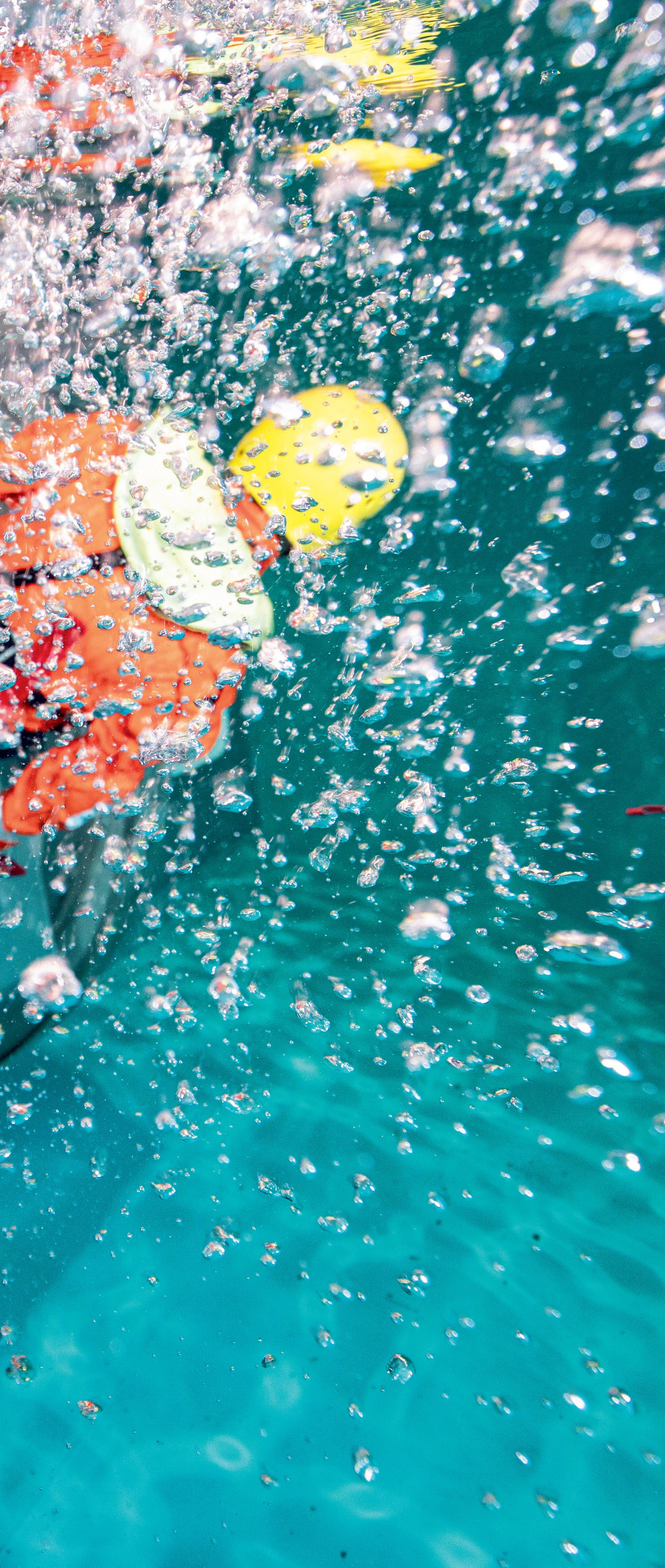
Since then, the organisation has grown into a well-known and valued authority in the feld of safety training, education, and consultancy. When looking on DRTC’s website, one will fnd a large variety in practical and theoretical courses, which indicates how broad and deep the range of education offered is.
According to Managing Director of DRTC, Bas Gloudemans, it is the right combination of own experience, and that of specialised third parties that enables the institute to offer any type of training necessary to stay up to date with safety rules and procedures at sea. “At our training centres in Vlissingen, Groningen, and Curaçao, maritime and offshore professionals are able to follow an extensive range of courses”, Mr Gloudemans says. He continues, “Many of these courses we arrange in close collaboration with among others, HZ University of Applied Sciences’ De Ruyter Academy, and the Maritime and Logistic College of Scalda, that both offer maritime and offshore education at hbo and mbo level. HZ and Scalda offer technical oriented courses for their students, and we provide them with the necessary safety trainings. The maritime and offshore students from HZ University as well as from Scalda that are going to have an internship at sea need to conduct the basic training which we provide to them. Apart from training students we also organise courses for professionals from the offshore and maritime industry.” DRTC has modern and extensive training facilities in Vlissingen, as well as in Groningen and Curacao, to provide theoretical and practical courses, however, training can also be offered on location. “We not only provide education at our centers”, Mr Gloudemans explains. “On request we also organise trainings on the job. With our skills and experience we could well be considered experts in training.”
Throughout the years, a lot has changed in the area of safety trainings. “When we started offering offshore and maritime safety trainings, no real regulation existed. People working at sea were considered as being capable to act safe and secure, and it was not compulsory to keep up to date in one’s safety skills. It really depended on shipowners, O&G operators, and offshore contractors how they dealt with this. The O&G industry was one of the frst sectors that introduced mandatory safety trainings with a periodic refresher; in 2010 the Maritime industry followed.” Working
at sea means that you must rely on yourself and colleague crew members when an incident occurs. The frst minutes of an accident are the most crucial for responding and at sea it will take a long time before assistance from the shore will arrive. Therefore, at sea people need to know how to react, when for example a fre starts, or in case someone gets injured.
By following a basic training everyone on board will know for example how to recognise a dangerous situation, what to do when someone gets injured, or in case of a fre, et cetera.”
Next to the various basic trainings, additional specialised courses can be conducted through DRTC for the various functions on board, on an oil or gas platform, or on an offshore wind farm. “We even organise soft skills courses like crisis
management and resource management”, Mr Gloudemans states. “These specialised courses are growing in relevance as, for example, systems on board become more and more complex. This can cause more pressure on people in cause of an incident. For training this kind of stressful situations we make use of simulators with which we can offer our trainees all kind of unexpected situations. They must deal with various calamities and learn how to deal with them in a proper way.”
The COVID-19 restrictions resulted in a new way of conducting trainings and examinations. Caused by the pandemic, we started to offer our theoretical trainings and exams online, and this happened to work out quite well”, Mr Gloudemans elaborates. People were able to conduct our courses or do their exams online from throughout the world, and even from their vessel or platform. The success of this made us decide to continue offering online courses, which of course is very effcient for people working at sea for weeks or even months.”
One of the challenges DRTC has to deal with is the fact that today, vessels and platforms need fewer people on board, and also with the ongoing digitalisation less technicians are needed to execute inspections and maintenance at sea. “In the Netherlands the oil & gas industry is decreasing and the amount of unmanned platforms rise”, Mr Gloudemans states.

“The growing offshore wind industry offers some interesting opportunities. Originally, this industry adapted oil & gas standards, but today they more often choose shipping or the Global Wind Organisation standards.
As long as people are not leaving the offshore installation

vessel, they only need to have the basic maritime training. However, when they leave the vessel, for example to work on the installation of TPs on monopiles, additional training is needed, such as for working at height. Positive for us is that the GWO standards demand for a biannual repeat training, whereas most O&G related basic courses only need to be repeated every four years.”

According to Mr Gloudemans, an interesting development in the maritime sector is the use of new, more environmentally friendly engines. “The use of green fuels,” he voices, “requires different care and treatment compared with the traditional fossil fuels. This will result in new trainings and certifcations. However, adapting to this development is not easy because only few standards for this exist. Still, it is important to be prepared for this development. Another market we are current looking at is the cruise industry. As this industry is still increasing, it offers a lot of opportunities. Cruise vessels have a large crew on board, not only for operating the vessel, but for serving the guests on board as well, and all this staff needs at least the basic maritime safety certifcations. Also, with the routes of cruises becoming more and more challenging, such as to the artic region, additional training for the staff is necessary.”
Apart from providing training to maritime and offshore crew and technicians, DRTC also acts as an advisor in the feld of safety, and when looking at this, Mr Gloudemans sees new opportunities in the superyacht industry. “We are often asked by shipowners, naval architects, and yacht builders, how to deal with safety on board, for example when looking at the right routing on board”, he explains.

When looking at the future, Mr Gloudemans sees a development in which less people in the maritime and offshore industry will be needed and the role of technology will grow. “With fewer people in combination with more technological solutions, we expect that pressure on safety will grow. People will require more and different safety skills to be able to deal with complex situations. Also, when looking at training and examination, I think that online and hybrid training and examining will continue to take a larger share in our curriculum. No matter how, new developments mean that we need to keep investing in our knowledge and facilities, as well as in the trainings we offer. Adapting to market developments is not always easy, as it is hard to predict what the market will ask for. In fact, as a training institute we often follow the market, whereas in the ideal situation, we should be ahead of it. One example of a recent investment based on market demand is our helicopter escape simulator. In the water basin at our training vessel ‘de Lingepoort’ that we installed last year, a so-called Helicopter Underwater Escape Training unit. In this HUET, people can learn how to act when the helicopter they are fying in gets under water. With this investment, we are adapting to the growing demand from both the O&G industry and the offshore wind industry. More and more installation vessels have a helicopter platform on board, for example for crew changes or incidents. Also, more and more helicopters will be used for the inspection and maintenance of offshore wind farms. With our new facilities we can help offshore crew and technicians to get the necessary training and certifcation to be allowed to be transported by helicopter to and from their work at sea.”

North Sea Port the 60 kilometres long cross-border port area stretching from Vlissingen over Terneuzen in the Netherlands to Ghent in Belgium





On a regular base, one can see a small vessel branded with an IGL logo sailing along the Zeeland coast. Although not visible, the vessel is gaining ample valuable information about the bottom of the sea during its trip.

IGL is a survey company that offers services in the feld of hydrographic, hydrologic, and geodetic surveying. The company was founded in 1981 with a focus on terrestrial survey. “Terrestrial survey has always been a price competitive market”, Jos Cremers, CFO of IGL explains, “which is why in those days, we were primarily active locally in the south of the Netherlands. Our work mainly consisted of measuring the terrestrial situation for residential and commercial construction.”
Mr Cremers continues, “In 1991, when Roger Vilters, the son of the founder of IGL joined the company as CEO, hydrography also became an important part of our work. With hydrography, we expanded our activities which really brought our company into overdrive. In 2008, the crisis in the residential and commercial constructions industry brought our growth to a halt. This was very inconvenient for us, as we had just opened our brand-new offce in Herten. In those days, we had approximately 1,500 customers in this industry, of which 400 were our active clients per year. Of course, such a broad clientele was comforting and gave us a solid base, however with the entire industry in a low, our business declined too.”
In 2011, Jos Cremers joined the company as Chief Financial Offcer, and together with Roger Vilters, one of the spearheads was to look for new possibilities. “Back in 2006 and based on our land activity-based name awareness, IGL was granted its frst hydrographic assignment to conduct survey works on the Limburg part of the river Meuse”, Mr Cremers says. “When I joined IGL, we were still a small player in the feld of hydrographic surveying. On the other hand, not many companies were active in this feld, as it requires ample knowledge and the ability to invest in equipment. This made us
decide to expand our portfolio in this discipline with a focus on longer-term contracts.” In 2015, the company’s efforts resulted in a frst contract with Rijkswaterstaat. Rijkswaterstaat (RWS) is the executive agency of the Ministry of Infrastructure and Water Management, dedicated to promoting safety, mobility, and the quality of life in the Netherlands. “Rijkswaterstaat is the Netherlands’ largest user of hydrographic surveying”, Mr Cremers elaborates, “and in this assignment, we were asked to map the beds of the water area of Zeeland, such as the Eastern Scheldt and Western Scheldt River. This mapping is important as the beds of these two rivers constantly change and move under the waterline. Keeping a constant eye on the riverbeds enables RWS to take the right measures to guarantee the navigability of their Zeeland water area.” The work with the Zeeland area was continued after the initial contract and also IGL was selected to also map several Dutch inland waterways from a hydrographic and hydrologic perspective, including the IJsselmeer. Both contracts are for a time span of six years. “We were considered a thorn in the side of the established hydrographic mapping companies, but with the RWS contracts we have become part of the Dutch top in the market for nearshore and inland mapping of water foors”, Mr Cremers proudly states.
Although, through the years, IGL has grown into a company with around 40 employees located in three offces throughout the Netherlands, one in Herten, one in Utrecht, and one in Vlissingen, the company is still able to act fast and fexible. Mr Cremers gives an example of this, “When looking at hydrographic surveying, we have a feet of small surveying vessels. They are portable and easy to transport with a trailer. This way, they are very fexible to operate at any Dutch inland waterway as well as nearshore to a maximum of 10km off the coast. And in case our customers ask us / require us to go further offshore, we can make use of vessels of our customer, or we hire in vessels from other companies. For example, we recently made use of a CTV that had to transfer technicians to an offshore wind farm. While the technicians were working on the turbines, the CTV had to wait, and during these ‘normal unproductive hours’, we could conduct surveys with the equipment we had installed for this purpose underneath the vessels. Thereby creating a win-win-win; a win for the CTV company and IGL, a win for the windfarm operator for a costeffective solution, and a win for the environment for minimising the number of movements to and from the windfarm (e.g., less fuel consumption equals less CO2 exhaust). We have a control

room in our offce in Herten from where the survey could be taken care of remotely. Our people were not on board of the vessel. This saved our customer money and it was also safer, sustainable, and more effcient.” For the upcoming years,

one of IGL’s challenges is to keep staff in line with its growth. “Currently, in order to achieve this (goal), we are making sure that we are a reliable employer and that it is fun to work for us Another challenge is sustainability, as our company too, will have to take the proper steps to reduce our ecological footprint. One of the steps we have taken in this matter is the investment in the use of fully electric drones for nautical surveys.”
Having expanded its hydrographic surveying activities does not mean that the other surveying jobs are no longer relevant for IGL. “Apart from hydrographic assignments, we have also been able to attract new business from long-term land-based contracts”, Mr Cremers elaborates. He continues, “In 2020, we have been jointly granted an assignment by the Amsterdam municipality. Together with two other companies, we monitor the deformation of all quays and bridges. In 2021, ProRail was added to our list of customers. Together with a second contractor, we are checking the profle of the Dutch rail tracks and the trains’ free moving space. Trains need to be able to ride freely, without the risk of touching things. That sounds logical. However, because of slumping of the soil for example, the rail tracks may slightly deform which results in a change of the way trains move over the rail track. To give an example, trains need to be admissible for wheelchairs and therefore the distance between trains and platforms must be as small as possible. This only leaves a small margin for the track deforming as this may result in trains touching the platform. And therefore, it is important to continuously monitor the rail track and the free space available for the trains to make sure ProRail knows when it is necessary to take the right measures in time.”
With an impressive portfolio of many satisfed customers, IGL can call themselves masters in surveying on land and on water. For the future, IGL aims to bring in at least one of this kind of

long-term projects every year. “Long-term projects for the larger customers form the foundation of our activities”, Mr Cremers voices. “They help us meet fuctuations in our residential and commercial construction activities. The residential and commercial construction industry is quite volatile, whereas the long-term projects are better plannable. Also, the latter allow us to make investments. These investments, together with our fexibility and our efforts to always do what we promise, have brought us were we are now. I often compare our portfolio with a cake. The long-term projects are the base of the cake and the measuring activities for residential and commercial construction form the decoration. Both are necessary for a good looking and tasty cake”, Mr Cremers concludes.

Offshore Energy Exhibition & Conference 2022 will bring the offshore energy industry back together again on 29 and 30 November 2022 in Amsterdam RAI, the Netherlands.

Europe’s leading event for the entire offshore energy industry forms the perfect opportunity to reach business leaders, highly qualifed experts, and professionals across global markets. We look forward to two days flled with networking opportunities, sharing knowledge, and shaping the future of energy together.
Expected number of exhibitors and partners: 450
Expected number of speakers: 80
Expected hours of content: 55
Expected number of visitors: 9,000
Expected number of nationalities: 82
I. OFFSHORE-ENERGY.BIZThis year, OECC 2022 will include the North Sea Port Pavillion again, located at booth number 1704. As far as is known, the following companies from the North Sea Port Area are joining the North Sea Port Pavillion: 1704 Actemium
ASK Romein
BOW Terminal North Sea Port Overlasko Konstruktie Promotion Council North Sea Port Shipyard Reimerswaal
A selection of companies from the North Sea Port Area who will be represented at the exhibition with their own stands: 1313 Damen Shipyards 1528 FMJ Marine & Offshore 1423 Holland Shipyards Group 1528 LGH Europe 1502 Liftal Marine Trading & Service 1211 Mammoet 1606 Multraship Towage & Salvage 1229 OOS International 1312 Seacontractors 1139 TOS People & Ship Delivery

As a representative of the building materials cluster, one of the spearhead sectors of the port, and with its focus on circularity, sustainability, and added value, AC Materials is a fne example of a company that can tick several boxes in the list of strategic programmes and ambitions of North Sea Port. With its new location at the Kluizendok, AC Materials gained the opportunity to take additional steps in each of these felds.
Until last year, AC Materials exploited two sites in or near North Sea Port. The frst was located in Wondelgem, very close to the site of its sister company Aclagro and on the left bank of the sea canal to Terneuzen; the second one was in Desteldonk, on the right bank. Road works in Wondelgem and the end of a lease in Desteldonk forced AC Materials to search for a new location. It found what it was looking for at the Kluizendok, where it took a concession with North Sea Port for 15 hectares at the northwest corner of the dock.

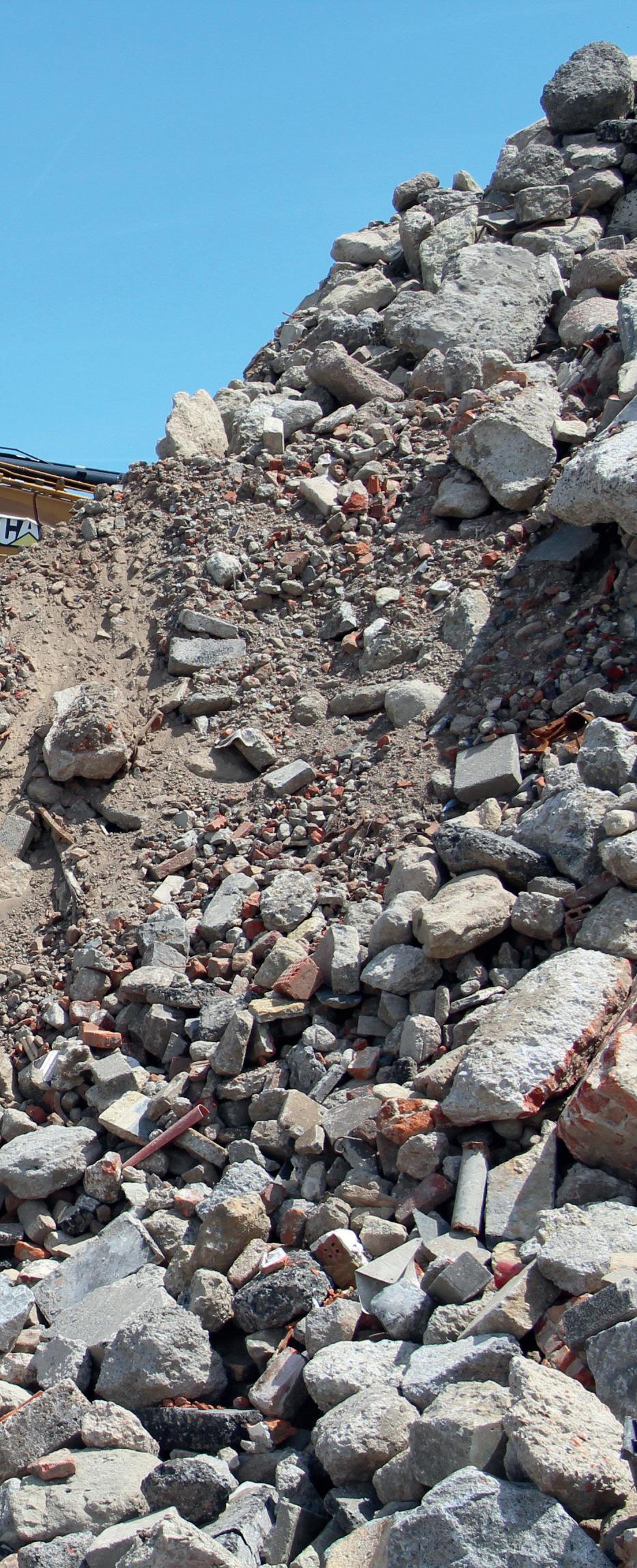
“Here at the Kluizendok, our main activities are threefold”, says Managing Director Johan Baeten. “We recycle construction and demolition waste into secondary raw materials that fnd their way back to the building sector. That is our core business. In line with this, we valorize part of these fows by producing specifc types of concrete out of recycled aggregates in our mixing plant. Last but not least, we are licensed for the temporary storage of non-polluted excavated soils waiting to be reused, a growing need in the soils movements business where traceability is strictly regulated.”
One of the important advantages of the new site at the Kluizendok is that it offers additional space to grow the existing activities and expand into new ones. “We use a bit more than 10 hectares for now, which is comparable to the total surface we had in Wondelgem and Desteldonk. We keep the remaining four to fve hectares as potential for future developments. Recycling of building materials is on the rise, so we may very well need extra space for this business. The future lays in the upgrade of recycling, trying to get the purest recycled aggregate. To come to this result, fows need to be treated separately and space is the trigger.”
“Our frst objective is to have our new installation fully operational and perfectly tuned. For instance, the temporary mobile crushing installation is soon to be replaced by the fully revised and upgraded fxed crusher from our previous site.”
“Volume wise, we aim at keeping the yearly rhythm of 250,000 to 300,000t handled in recycling construction waste (the same volumes are noted outgoing, representing about 40 trucks in and out each day). From that volume, about 97 to 98% is recycled in different applications. Of course, we have spare capacity to raise that volume further in the coming years.”
AC Materials invested about EUR 10 million in its new recycling centre and storage platform at the Kluizendok. It devoted a lot of attention to a qualitative lay-out of the installation and to a rapid turn-around of the visiting trucks.
“We have separated the different fows and built broad lanes for more fuidity and safety in our operations. At the entrance and exit of the terminal, electronic booths allow drivers to perform the needed checks without having to leave their truck. We
AC Materials is part of the much larger Square Group, which through internal growth and external acquisitions expanded over the years in four main activities.
The contractor division Aclagro served as the starting point in 2004. It is active as contractor in infrastructure work, demolition (including asbestos removal), soil sanitization and remediation. Aclagro has a soil cleaning activity with AGRC in Wondelgem.
The recycling of construction and demolition waste into secondary raw materials for reuse in new infrastructure projects was integrated in 2012 into AC Materials. With its fve sites (Brugge, Ghent, Vlierzele, Puurs and Heist-op-den-Berg), AC Materials covers the larger part of Flanders, yearly recycles about 850,000t of demolition and construction waste, remixes 500,000m³ in its concrete plant and has the capacity to temporarily store 200,000t of excavated soil, making it “the biggest recycling company in Flanders”.

Oryx Projects focuses since 2014 as a separate entity on the redevelopment of urban brownfelds such as the Tondelier site in Ghent.
Making maximal use of the waterway whenever possible, Square Group also forayed into transport with DD Shipping. It manages two terminals on the sea canal to Brussels (in Puurs and Grimbergen) that can receive coasters and handle a wide range of inter-company and third-party fows.
Square Group has its headquarters in Wondelgem, Ghent, employs about 500 people and has a turnover of EUR 110 million. AC Materials accounts for 80 people and EUR 45 million.
I. SQUAREGROUP.BEalso put a lot of emphasis on the fast loading and unloading of trucks, because time and effciency are of great importance in our business. As we offer different products, trucks delivering products are welcome to take new products with them, reducing empty transport.”

AC Materials also enhanced its technical capabilities. The new mixing plant is served by more aggregates’ bunkers, allowing it to process added combinations of materials to obtain an increased number of varieties of concrete.

The group did more than just duplicate what it did previously. Next to the breaking and sifting, AC Materials can now add extra value to the crushed aggregates by washing them. “Our brand-new washing installation makes it possible to extract high-quality aggregates from the waste we receive. This opens the door for the production of higher-grade recycled concrete that can be used for certifed applications. This can be seen today as a full replacement for concrete produced with natural aggregates. It is part of our drive to more added value.” The quality of these products can be checked in a lab on the site itself.
One of the main ambitions of AC Materials is using the port connection to expand water-borne traffc at the Kluizendok.
“Our former sites in Ghent already offered a direct connection to the waterway, the Ringvaart in Wondelgem and the Moervaart in Desteldonk. In our recycling activities access to water is a very important strategic item, especially with the high volumes we treat.”
“We already use inland navigation to some extent, for the delivery of raw materials and for some intra-company traffc. Yearly we receive about 50,000t of sea sand by barge via Vlissingen and at least 15 to 20,000t of demolition waste and excavated soils. But there is defnitely room for growth in this respect.”
Mr Baeten expects that incoming and outgoing transport of demolition and construction waste by the waterway will go up in the coming years, if only because an increasing number of clients require so. “On top of that, our location at the Kluizendok should allow us to attract additional fows, including maritime ones, like sea gravel. The production of higher-grade products could as well have a positive impact on the share of the waterway in our modal split.”
For the time being AC Materials is using the quay and services of an adjacent company to handle ships and barges. In due time, the company will organize its own direct access in the Kluizendok.
Outgoing fows mainly happen on wheels. “For products with a lower value and that are destined for regional markets, the cost of transportation is an important factor and road haulage most often still is the most competitive solution. We mainly serve a regional market: 95% of our volumes stays in Flanders. We now sit closer to the border with the Netherlands, so we are looking into the potential of Zeeland for us. With our shift to the north, we knew we would have to reorient ourselves a bit.”
It is part of AC Materials’ nature to aim for circularity, the Managing Director underlines. “It all starts with recycling aggregates instead of using new ones. But we go further than that. We have a growing number of hybrid equipment. A windmill and solar panels deliver green electricity to power our breaking machine, which is the beating heart of this recycling platform, and our sifting installation, which both consume quite some energy. Washing is a new development in our cradle-to-cradle story, since it allows us to market higher-grade applications. It runs on the rainwater we collect and reuse in a closed circuit.”
AC Materials is actively pursuing – and investing in – new technologies to improve every step of the recycling process and new applications for the products it delivers, he adds. “It is one of our trump cards, together with our client-mindedness and the diversity of our activities, which results in synergies and the possibility to offer our customers a total package, from the start of the demolition to the reuse of recycled materials, including intermediate storage of excavated soils. With our new site at the Kluizendok we stand ready to go even further than we already did.”
Incoming and outgoing transport by the waterway will go up in the coming years.

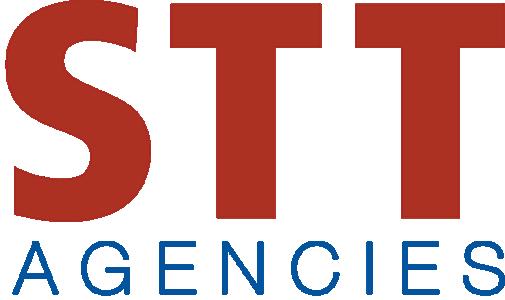
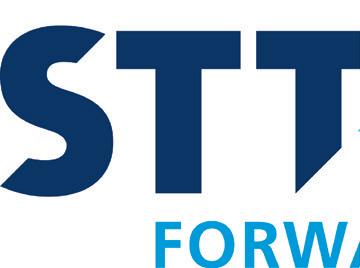
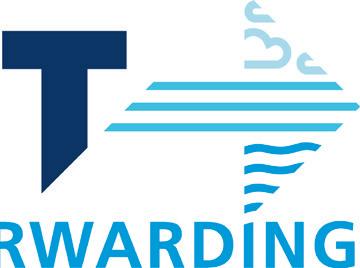





65 years ago, OVET started its activities in the Terneuzen port area of North Sea Port. In this article, Managing Director Vincent Courtois explains how the company was able to adapt to changing circumstances throughout the years.
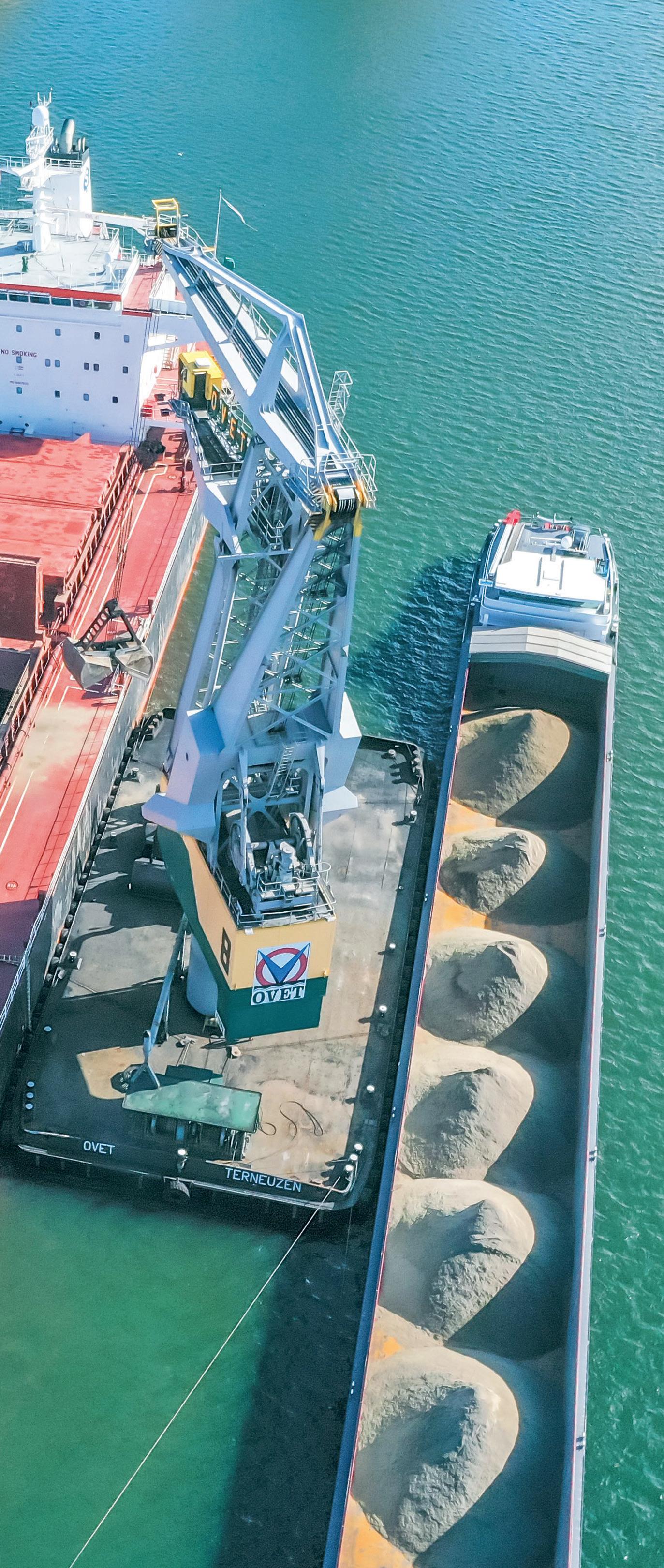
The history of OVET begins in 1957, when the French stevedoring company Manufrance decided to establish a local transshipping company for a major customer, the Association Cooperative Zélandaise de Carbonisation, located in Sluiskil alongside the Ghent Terneuzen Canal. This factory was better known as the Cokesfabriek (coke factory). “The coke factory in Sluiskil focused on the production of cokes for the blast furnaces of French and Belgian steelworks. Sluiskil was a perfect location, because it is well-situated with regard to England and the Ruhr area, which is where the coals came from in those days. The deep waterway was also a major advantage.”
The managing director at the time, Mr Simenel, started out with seven other employees and ran the company from the Grand Hotel Rotterdam in Terneuzen. From an annual 500,000t of transshipment during the beginning, OVET has grown to over 11t million of transshipment in 2021. “Throughout the years, our company had to deal with various challenges”, Mr Courtois says. “One of the frst challenges was caused by the declining demand for merchant coke which in the end resulted in the closing down of the coke factory in 1999. Meanwhile we had been able to expand our customer base and because of that we were not totally depending on the coal volumes for the coke factory. First of all, we started to supply coal directly to the French and Belgium steel factories when they were able to produce coke themselves, and in the 1980s we opened a terminal in the Vlissingen port area to supply the powerplant over there with coal. In those days, oil and gas became too expensive which is why it was decided to reft the powerplant for the use of coal. In 2015, the coal powerplant had to close its door because of the energy transition, meaning we lost an important client for coal. Being capable of receiving Capesize vessels without tidal hinderances, the Vlissingen terminal has been able to respond to this loss.”
Mr Courtois continues, “With the current crisis in the Ukraine, OVET is facing a next challenge, because it will no longer be allowed to import coal from Russia as of 10 August. Russia is an important supplier for high quality coal that is used in steel production, and it is obvious that missing this amount of coal is felt by everyone involved. One of our advantages is that we are an independent terminal operator and with steel producers looking for alternatives for the Russian coal all over the world, we are very well capable of handling this coal at our deep-water terminals. Another effect of the war is that governments are currently looking for alternatives to oil and gas, meaning that for the
production of energy, demand for coal is on the rise again, which is contributing to the saturation of ARAG terminals as well. Of course, this will only be a temporarily revival and when the oil and gas market will stabilise again, demand for coal for electricity production will drop rapidly as a consequence of the energy transition. Therefore, OVET does not focus on steam coal, but rather on process coal. On the other hand, since I joined OVET in 2015, just before the coal power plant in Vlissingen closed, we have had our goals set on reducing our dependency on coal, and today the share of coal has dropped to 50% considering the rising volumes of iron ore and a diverse
portfolio of other commodities handled. If it is up to us, this percentage will only get smaller every year.”
When looking at bulk good, OVET’s portfolio has grown into a broad range of goods. Today the company handles coal/ (pet)cokes/anthracite, minerals, fertilisers, slag, incinerator and fy ash, agricultural products (seeds/grains), (GMP) biomass, offshore/density stones, and scrap. It is the company’s goal to raise the amount of non-coal non-ore related products to 25% in 2025, which looks like a realistic goal since the share is generally over 20% already today. Apart from bulk, OVET is also operating in the breakbulk market, more specifc, coils and slabs. “By constantly keeping our assets up to date, by a fexible approach of both our commercial team, as well as our people at the terminals, we have always had the power to reinvent ourselves again and again, with a continuous growth in volume and turnover as a result. In doing so we have always put our existing customers frst, by meeting their demands and expectations.” As a good example of the company’s fexibility, Mr Courtois mentions the foating cranes the company has always been using. “With our foating cranes we are able to swiftly move our handling capacity between Terneuzen and Vlissingen. Moreover, and this is quite unique in our region, the foating cranes enable board-board handling of cargo and lightening of vessels midstream. In the new markets that we are operating in, board-board handling is only a small piece of the market with relatively small volumes. This gives us the opportunity to compete with quality instead of with prices, while for the larger terminals that already are acting in these markets,


this type of cargo handling is not a key competence. However, many small quantities together make large volumes, so they are important to us. When looking at fexibility, our terminals have a versatile layout with a total of 490,000m2 of open paved storage room and 45,000m3 of covered facilities. Another not to underestimate example is the way our staff is dealing with our diversifcation. Our commercial team showed the ability to adapt to our strategy of diversifcation. This way they succeeded in fnding new cargo volumes. And don’t forget the operators at the terminals. They were used to handling mainly black bulk cargo and through the years they managed to build up the necessary skills and knowledge in the handling of other types of bulk as well as breakbulk.”
Looking back at 65 years, Mr Courtois can conclude that OVET has managed to stay on top of the market. With regard to the future he states, “What the upcoming years will bring is hard to predict, as today one thing is sure, namely that a lot is unsure, especially in the ports. Seven years ago, we have set our diversifcation strategy and so far, everything is going according to plan. After the war in the Ukraine, the further growth of renewable energy will continue, and it can be expected that the steel industry like other industries will have to take proper measures for a cleaner production. This will require green raw materials that will be transported to Europe in relatively small volumes from all over the world. With our fexible organisation and assets, we are ready to deal with these volumes.”
Throughout the years OVET has taken responsibility too and managed to reduce its ecological footprint by taking various
measures that range from relatively small ones such as the use of green energy for its sieving installation, and the use of LED lighting, to larger ones such as the installation of ultracapacitors on the foating cranes. Mr Courtois elaborates, “As a company we can proft from the energy transition, however for our license to operate it is important to take the environment into account as well. With the ultracapacitors, energy from lifting movements can be stored and used, which results in fuel savings. Today, three of four foating cranes have this system on board. It might be a surprise for many that the biggest fuel saving is realised by replacing diesel powered loaders by hybrid ones. For this, as European pioneer, we have acted as a pilot project for Caterpillar and now, almost all our loaders are hybrid. This saves us around 10% in diesel fuel annually.”
“With a decreasing demand for coal many might have thought that our company had no future,” Mr Courtois says. “However, we have proven everyone wrong. Of course, we have always moved along the waves of the economic changes. Still, we are in good health now and can expect a record volume of 13t million this year so we can look ahead with confdence. We cannot talk about the success of our company without mentioning our commercial partners. A lot we have managed is because of the excellent collaboration with many other companies at North Sea Port and industrial end users beyond. Of course, we look forward to continuing working together with them.”
 I. OVET.NL
I. OVET.NL
Recycling company Galloo has added a second push barge to its feet. The ‘Galloo 2’ has been custom-built to link the group’s sites in Northern France to its export hub in North Sea Port by using the Lys river for waterborne transport. It gives the logistics set-up of Galloo an extra push towards sustainability.
Galloo is a major player in the recycling business, handling 1,5t million of scrap iron, 200,000t of non-ferrous metals and 40,000t of plastics on a yearly basis. Since sustainability and circularity are at the core of its activity, the group is also eager to reduce the environmental impact of its supply chain, Peter
Faced with a strong growth in its activities and, consequently, of the volumes to transport, Galloo acquired a frst push barge, the ‘Galloo 1’, in 2018, with the main mission to carry ferrous metal scrap from the company’s main site in Menen, upstream of Kortrijk, to its deepsea export hub in Ghent. It proved a successful formula and allowed Galloo to make a signifcant modal shift towards inland navigation. Last year, the unit (which has a capacity of 2,300t but is currently used at 1,500t) transported some 120,000t. Galloo thus took the equivalent of 5,000 trucks off the road. The ‘Galloo 1’ shuttles back and forth between Menen and Ghent up to three times a week, accounting for about three quarters of the shipments out of Menen and sometimes taking return cargoes like sand with it on the trip back.

“Some 250,000t, almost one third of our total inbound volume, now comes to us by barge, with spot charters supplementing our own unit”, explains Lieven Neerinck, Site Manager & Export Ferrous Manager at Galloo Gent. The scrap terminal and ship recycling yard sitting at the junction of Grootdok, sea canal and Ringvaart in Ghent exports 800 to 900,000t each year. The bulk of that is loaded on seagoing vessels destined for countries like Turkey and Egypt that need imported scrap as feedstock for their steel industry.

With the ‘Galloo 2’, the recycling company takes its commitment to sustainable transport solutions a step further. The new unit was specifcally designed and built to ft the waterways connecting Ghent to the Lille region in particular, where Galloo has a very strong presence. It has a maximum capacity of 1,850t (but will run at 1,500t too), a length of 78m and a width of 10,5m, taking into account factors like free
height under bridges and water depth on the smaller canals and rivers in Northern France.
“The volume we carry on our own barges is expected to rise to 200,000t. Being able to rely on our own vessels makes us less dependent on the fuctuations a market like inland navigation is subject to”, says Lieven Neerinck.
The terminal in Ghent is ready for the job, he adds. In 2018, the year the ‘Galloo 1’ came into service, the terminal received an additional wheeled crane, which can assist the bigger railmounted equilibrium cranes for the loading and unloading of barges and seagoing vessels.
Mr Neerinck does not exclude that a third owned unit could follow in due time, even if no decision has been taken yet. Even the acquisition by Galloo of an own push boat could then become an option. Today, the company relies on the services of independent operators for the propulsion of the barges.
Galloo is also looking into the possibility to adapt additional water-connected sites in order to be able to handle barges directly at their quay. Another option is to make more intensive use of river terminals in their proximity to further increase the share of the waterway in the group’s modal split.

The Seine-Scheldt project, which will create a high-capacity waterway connection between the Seine bassin and Paris, the Scheldt and North Sea Port, could give a major boost to these plans. Flows like scrap lend themselves perfectly well to transport over water and stand to beneft heavily from this infrastructural development.
Recycling is one of the pillars of North Sea Port’s strategy, scrap is a very important commodity for the port and multimodality one of its trump cards. So CEO Daan Schalck could only express his satisfaction at the new development at Galloo’s. “This strengthens the anchorage of Galloo in North Sea Port”, he said.
Galloo has been active in Ghent for twenty years. It acquired the scrap terminal in 2002, turning it into a vital linchpin in its organisation. “Scrap is an internationally traded commodity. This is our gateway to the world.”
I. GALLOO.COMThe volume we carry on our own barges is expected to rise to 200,000t.Photo courtesy of Jean-Louis Vandevoorde. Photo courtesy of Galloo.

Martens Cleaning, part of Hoondert Group, has been recently taken over. Together with Nature Group’s International Slob Disposal, Martens Cleaning now forms the Environmental Services division of Rotterdam-based Burando Maritime Services.
Serge Hendrickx, General Manager of Martens explains to PortNews about this take-over.
“The reason for the sales of Martens Cleaning to Burando is actually quite simple,” he explains, “as the owner Jan Hoondert has plans to withdraw from business. This is why he is offering the various parts of Hoondert Group for sale. Jan Hoondert has been working 80 hours a week for decades, putting every effort in creating a successful company, and now that he is in his sixties, he wants to have more time for himself and to spend with his family.”
Martens Cleaning offers a comprehensive total package of services concerning the collection and processing of various types of maritime and industrial waste, industrial and ship cleaning, and calamity control on land and on water. “In the Vlissingen port area of North Sea Port, we have our own terminal with a 200m long deep sea quay from where we are taking in the collected waste”, Mr Hendrickx states. He continues, “In addition, we are involved in ship cleaning and calamity control in the maritime sector. We have a wide range of ships that are certifed for the transport of waste, such as low fash, oils, small chemical waste, and other types of waste. Next to this, making use of vacuum lorries, high-pressure units, hot-water units, and other specialised equipment, we are able to carry clean fuel tanks, cargo tanks and holds, and engine rooms.”
“Martens Havenontvangstinstallatie Vlissingen is our port reception installation”, Mr Hendrickx continues explaining. “This has a processing installation with a capacity of around 250,000t for the processing and storage of oil-containing wastewater and other oil-related waste products. We have a license to operate our reception installation and an international waste collection
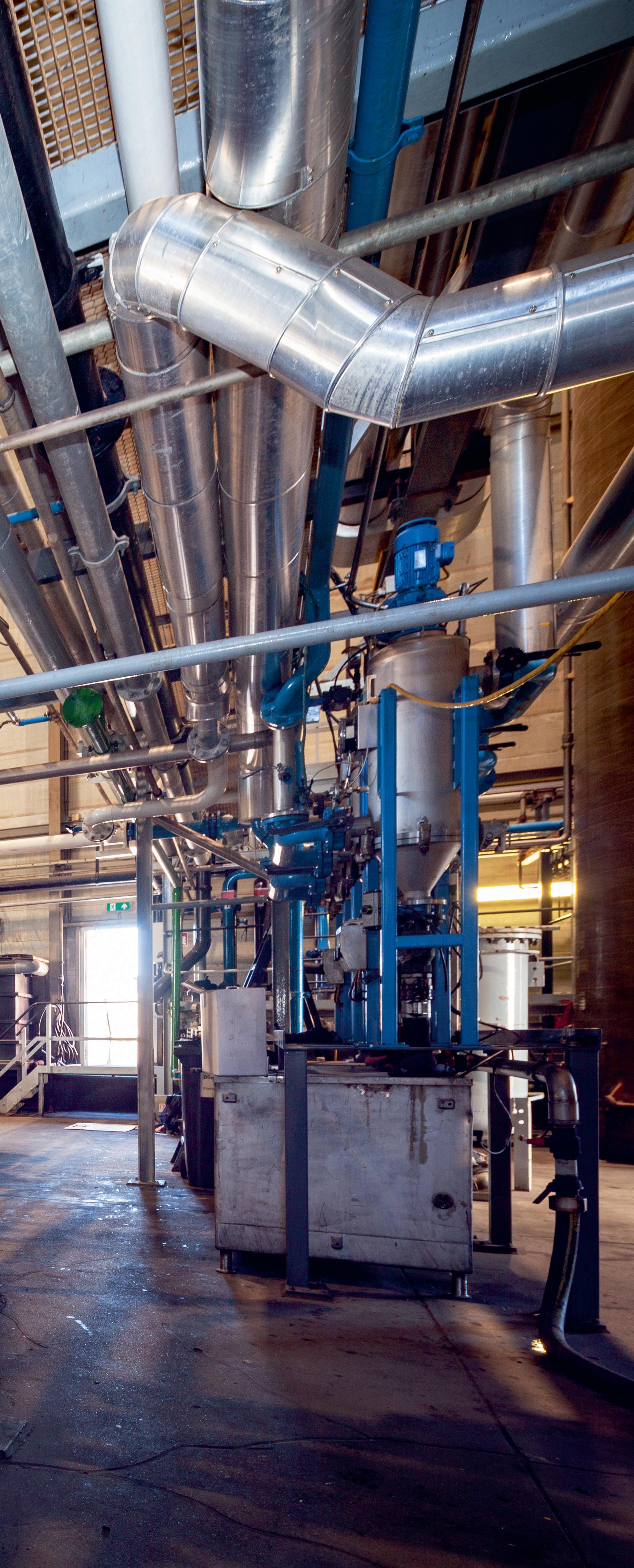
permit to collect maritime and land-related waste, to process oil-containing maritime and land-related waste, to collect and process ballast water and ship’s engine room waste, and to collect all washing waters.”


In our treatment processes, we derive for example the oil-based waste that we sell as usable raw materials for the petrochemical industry and we purify the water after which it can be given back to nature.”

Martens Cleaning is now the frst part of the Hoondert Group that has been sold and Mr Hendrickx is glad with Burando as the new owner. “The vision of Burando fts seamlessly to ours and when looking at the activities of Nature Group and Martens, both companies perfectly complement each other”, he says. “We are operating in a geographical area that ranges from the French/Belgium border up to Rotterdam, while Nature Group has its market from Eemshaven in the North of the Netherlands to Rotterdam. So there is only a small geographical overlap in the port of Rotterdam area. However, this does not mean that we share customers. Nature Group mainly aims at shipowners, while our customers are port authorities, ship owners, and shipping agents.”
According to Mr Hendrickx, both Martens and Nature Group are also complementary regarding waste collection and treatment. “When looking at the collection of ship and industrial waste,” he says, “Nature Group collects the waste and transports it to a third party for the waste treatment. At Martens we not only collect the waste, as we have our own waste treatment and water purifying installations. Being part of one company, Nature can transport the waste to us. This is good for Nature of course,
and it also gives our treatment activities a real boost.” When talking of a real boost, Mr Hendrickx sees more advantages of the acquisition for Martens that will help the company strengthen its position in the market. “Being part of Burando means that we now have around 500 new colleagues with a lot of knowledge and expertise as well as their barging and trading activities, which will help us expand our market.” Throughout the years, Martens has developed into a full-service company for cleaning and collection and treatment of maritime and industrial waste and the name Martens Cleaning doesn’t suffce anymore. “Because of our broader scope and our sustainable recycling activities, we have taken the opportunity of the take-over to rebrand our company into Martens Renewables”, Mr Hendrickx elaborates.


Mr Hendrickx joined Martens some ffteen years ago and has since been witness of the steady growth of the company. He is determined to further help expand the company. “Through my career at Martens,” he says, “I have always been given a lot of confdence by Jan Hoondert and this has helped me to lead the company almost like it was my own. Throughout the years, we grew from 26 employees to over 75, we expanded our treatment facilities, and the network for the collection of
waste grew as well. Although based in North Sea Port, we are now the largest waste collector for barges in Belgium, which is something not many people know. Apart from waste collection, we have also been able to expand our cleaning business which also resulted in growing transport activities. What I am proud of is, that as an environmental company, we not only put ample efforts in keeping all our permits in order and up to date, but we also work according to them. We still have a so-called clean sheet in this matter, which is quite special in our business. We have managed to do so by constantly keeping our knowledge up with changing rules and regulations.”
As described above, now being under the wings of Burando, Mr Hendrickx looks ahead with confdence, even though the demand for oil will decline because of the energy transition.
“With the current energy transition, we are fully aware that our market is ending at some point,” he states, “but for the next two to three decades fossil fuels will remain important, meaning that there are still ample opportunities to grow for us. Of course, the type of waste we will be handling will change and recycling of waste will become more important. To keep up with this development, we must continue to invest in our people and our equipment and installations.
For this, we also take the environment into account. We know that we can not only proft commercially from the environment by our recycling activities, we should also try to lower our own impact. For waste treatment for example, we make use of residual heat from Zeeland Refnery. This way, we have been able to reduce our need for natural gas by 95%. The remaining 5% is necessary as we still have a gas-powered steam turbine as a back-up in case Zeeland Refnery is not able to supply. Also, we have remotorised most of our vessels with stage V or higher engines. So, we have already invested seriously in sustainability and we will continue to do so. With Burando being a fnancially strong owner, we know that this will be possible and it will help us be prepared for a new chapter in our existence”, Mr Hendrickx ends.
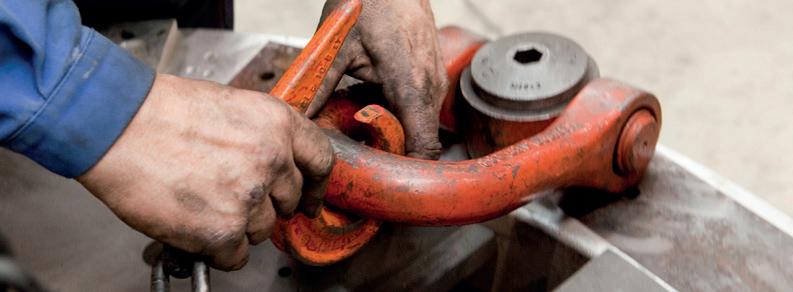
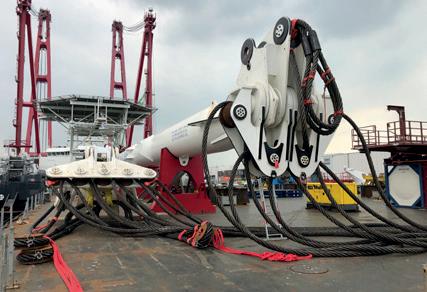


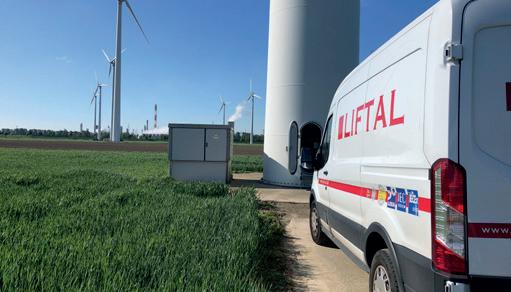


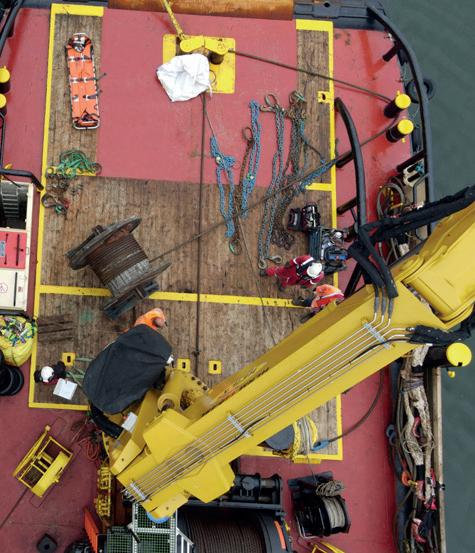

In a technical world, with changes going on all the time, growing up can be challenging. But not for engineering and manufacturing company Draftec. Although still a relatively young company, it has been able to build up an impressive track record and an excellent reputation in the offshore renewables industry
Currently owned by Martijn Boone and Martijn Holtkamp, it was founded by the frst mentioned in 2009. And although it skipped its 12,5-year anniversary due to the pandemic last year, the company has reason enough to be proud of its achievements. PortNews talks with Mr Boone about the company’s achievements.

“Ever since the beginning of our company, we have witnessed a healthy growth”, Mr Boone explains. “Still, growth is not exactly
a primary goal, as we strive to be a healthy company capable of helping our customers with their technical challenges.” He continues, “We started as an engineering frm and slowly we have changed into a multidisciplined company that designs, constructs, installs, and maintains high-end equipment and systems. We position ourselves as an innovative knowledge partner for our customers and what makes us extraordinary compared to other companies is that we are engineers who construct things, whereas normally it is the other way around. This means that our company mainly exists of engineers, with a relatively small amount of construction and assembling technicians.
Still, growth is not exactly a primary goal, as we strive to be a healthy company capable of helping our customers with their technical challenges.Martijn Boone (l) and Martijn Holtkamp (r), owners of Draftec. Photo courtesy of Suzan Fotografe.
One of the fastest growing markets for Draftec is the renewables industry. Mr Boone explains, “We design, build, and install cable laying and installation equipment for offshore wind turbines, such as cable tensioners, (motion compensated) winches, handling frames, roller tracks, steelwork, and other special tools. For this, we can rely on our in-house knowledge in the felds of mechanical design, hydraulic systems, electrical systems, and control system software and automation. With our cable tensioners we belong to the top of the industry, and we are supplying them all over the world. These cable tensioners are a good example of how we look into details. For the nylon cable guides we use two colours, black and yellow, instead of one. This sounds like a cosmetic detail, however it enables people to see from a distance, for example from the wheelhouse, whether or not the tensioner is running.”

Mr Boone continues, “With our products we now are a valued partner for the offshore wind industry, with returning customers such as Boskalis, DEME, and Van Oord. Working with them gives us the opportunity to build long-term relationships with both our customers and suppliers. Today we are partnering as subcontractors in several offshore wind tenders. Also, certifcation institutes such as DNV know where to fnd us for our advice. As unrestrained growth is not our primary goal, we carefully chose the markets we are operating in. Apart from the renewables industry we also work for the maritime industry, the dredging industry, the civil industry, and the petrochemical
industry. With our expertise we are also on the forefront for the various green hydrogen production developments at North Sea Port. So, we look at this development with a lot of interest.”

“Being based in Zeeland since our foundation, with most of our staff living in this province, we have our roots frmly anchored in Zeeland soil”, Mr Boone says. “Despite our growing portfolio of international companies and supplying our products all over the world, we stick to these Zeeland roots; we are hard-working, down to earth, and honest. I think that our customers choose us partly because of this, as for example the maritime and offshore industry too are acting quite down to earth themselves.
Of course, they also value our knowledge and expertise, and our think along attitude. Although we are growing up, we prefer to continue acting like a young company: fexible, fast forward thinking, and above all, innovative. Apart from this, being located in Zeeland, close to the North Sea Port area with plenty of quay space for installing equipment on our customers’ vessels, and many experienced suppliers, is also something that gives us an excellent proposition.”


According to Mr Boone, the availability of relevant companies in the region not only helps to attract customers. “With so many relevant companies around us in Zeeland,” he elaborates, “we always try to look for collaboration. Joining forces enables us and companies we are working with to add value to each other’s business. It also helps us to stand stronger towards competition. Despite our good reputation in the international market, however, we somehow lack name awareness in the region. There are still many companies in Zeeland that we could be working with that do not know what we are capable of and how much we can offer them. Therefore, one of our challenges today is to work on our regional name awareness.”
When looking at name awareness, Draftec has to deal with another challenge. “For our organisational growth, Martijn Holtkamp and I have set a personal goal to passionate people to join Draftec”, Mr Boone voices. “It is true that in the current market this is a challenge however, with for example offering internships for students we try to get our company top of
young people’s mind. We are proof that it is possible to have an interesting and challenging technical career in Zeeland. One of the aspects in engineering and designing that has become more and more important is digital prototyping and digital twinning in which we already have an excellent reputation, however for these new techniques we can offer young people great career opportunities. With our growth from designer to multi-disciplinary company, we also need to meet with various production standards, and this is why quality control and certifcation has become more relevant than ever, and for this we also require people with specifc knowledge in this area.”
When he started Draftec in 2009, Mr Boone was 27 years old. Now thirteen years later, provided with ample experience and wisdom, he looks differently at doing business. “At the start of the company,” he states, “I didn’t have much time to think of what exactly I was doing apart from running a company. Now that business is going well, having an excellent partnership with Martijn Holtkamp, and of course backed-up by our motivated and skilled employees, the company has arrived in a stage in which we now have time to enjoy our achievements, and to be proud of this. Also, both Martijn Holtkamp and I have learned that there is more than fnancial proft. Of course, our customers are still important, but now we also look at other stakeholders, and our environment. Operating from Middelburg, we contribute to the Zeeland economy and employment, and we hope to be able to continue this for many more years to come.”

In June, Cargill offcially opened a state-of-the-art advanced biodiesel plant at its site in Ghent. Converting liquid waste oils and fats into third-generation renewable fuel, the facility marks the frst foray of the American food multinational into a totally new feld. It also strengthens the position of North Sea Port as a major hub for the production of alternative fuels and as a breeding place for the circular economy. And more is to come, Cargill announced.
At the grand opening of the new plant, which is one of the largest waste-to-biofuel facilities in Europe, David McLennan, CEO of Cargill, made it perfectly clear that this was not just another project for the multinational. “We’re marking a new milestone in innovation in Ghent and one that has the potential to transform the transportation and shipping industry, to support Europe’s transition to a carbon-neutral future and to create a new model for a circular economy. This is a best-
in-class example of how innovation, partnership, and focus on the environment can drive real economical results. It also demonstrates that businesses like Cargill can lead the way and support our customers’ decarbonisation journey.”
Alongside other alternative fuels, the advanced biodiesel produced at the facility will mainly be used by the maritime and trucking industry, which represent almost a quarter of Europe’s greenhouse gas emissions. This will allow these sectors and

their users to lower the carbon footprint associated with their supply chain and distribution activities. Cargill is committed to this task: in 2020, it was one of the founding partners of the Maersk Mc-Kinney Moller Center for Zero Carbon Shipping.
“We are providing a concrete, cost-effective solution that meets global renewable energy demands, respects environmental needs, and helps customers realise their greenhouse gas commitments.”, states Alexis Cazin, Managing Director for Cargill Biodiesel & Carbon EMEA.

It is a ground-breaking development for Cargill, he underlines.
“Until today, waste recycling was not part of our core business, but sustainable development has truly become a core value for us. This plant is part of our contribution to the fght against global warming. It is also a contribution to the energy independence of Europe. Cargill is not shy of making bold steps when there is both a purpose and a business case.”
The frst discussions started in 2017. “There was some wishful thinking about building a new plant with a technicality we did not master”, Alexis Cazin recalls with a smile. The project took fve years to complete, suffering some delays due to the COVID-19 pandemic and foods on the Rhine that halted delivery of essential equipment like electric wiring.
Ghent became the frst Cargill plant employing industry-leading waste-processing technology to convert all types of liquid waste oils and fats, including cooking oils, tallow, and residues from edible oil refnery – products that previously were disposed of or relegated to low-value applications – into advanced biodiesel.
“That is the magic of this plant: we take some of the worst
feedstocks and we turn them into a distilled, transparent, topnotch product.”
The technology designed by greentech solutions provider BDI was completely new to Cargill. It has already been implemented in two other plants in the world, in California and Hungary, but the Ghent facility is twice as big in terms of capacity and thus presented a new challenge.
“The production process requires a pressure of 80 bars and a temperature of 260°C. So far, we were not used to work at such high levels of pressure and temperature. In our existing biodiesel plant, we work at atmospheric levels and at a much lower temperature”, Plant Manager Steven Matthijs explains.
One of the most impressive moments in the building process was when a special convoy brought in the giant distillation column – nicknamed ‘Big Bertha’ – that is at the very heart of the new installation. But the new plant has many other special features. The operators who control the fully automated installation are sitting in an explosion-proof bunker, which also houses a laboratory where production samples can be analysed. For the production of the steam needed in the process, Cargill relies on the biggest hot oil boiler in Europe.
Running on a 24/7 schedule, the biodiesel plant also creates twenty new direct jobs and 60 indirect jobs. The plant operators were hired a year ago and underwent a thorough training. Total direct employment at Cargill’s Ghent site rises to close to 170,
This new plant confrms Cargill’s long-term commitment to the Ghent tech valley and to North Sea Port.An impressive special convoy was needed to bring in the giant distillation column – nicknamed ‘Big Bertha’ –that is at the very heart of the new installation. Photo courtesy of Cargill.
when including the oilseeds crushing plant and the existing, frst-generation biodiesel Bioro facility. The new plant does not interact at all with these two other facilities, if only to avoid any risk of contamination.
The investment of USD 150 million in the Ghent plant allows for the production of 115,000MT per year of third-generation biodiesel, replacing the yearly diesel consumption of 150,000 cars or 10,000 trucks, and avoiding the equivalent of 370,000t of CO2 emissions and the disposal of 120,000t of waste each year.
Procurement of the needed feedstocks – some 130 to 150,000t depending on the products involved – will happen on a scale ranging from local to worldwide, with the main volumes originating in Europe. Flows will be coming in by truck, inland barge, or sea-going vessels. Trucks and barges will be handled directly at the plant, which has a mooring quay for inland vessels at the adjacent Moervaart. Dedicated pipelines will connect the plant to the waterside. Sea-going vessels will deliver their cargo at a new tank farm logistical partner
Ghent Transport and Storage (GTS) is building at the nearby Kluizendok, on the left bank of the sea canal to Terneuzen, under a new joint-venture named Ghent Renewables, of which Cargill holds a 20% share. These feedstocks can receive a pretreatment there if needed before being shipped by barge to the Moervaart.
Mr Cazin expects that about half of the feedstocks will originate from inside Cargill in about three years’ time, helping the group in its own decarbonisation and zero-waste drive. “We have plants in every part of the world. It takes time to organise the procurement, map all the waste we have and to redirect it to where we can process it. In Ghent we will be able to maximise a number of internal fows and to valorise part of our waste and by-products.”

The biodiesel is destined to European producers of biofuels, with maritime bunkering as one of the primary markets, but also chemicals, paints, and so on. Cargill can store the new biodiesel on its own premisses in three tanks with a capacity of 11,000m³ each.
Actual production started in July, but the further fnetuning of the whole process will take months. Outgoing fows will mainly be water-bound, again by barges and ships in the frst place, but the factory has four of its own loading stations for trucks.

Alexis Cazin had a fnal message for the audience attending the offcial ribbon-cutting ceremony. “This new plant also confrms our long-term commitment to the Ghent tech valley and to North Sea Port. We have found here an ecosystem of stateof-the-art infrastructure, highly specialist partners, pragmatic and supportive institutions, excellent universities and all kinds of innovations that convinced us that Ghent is the ideal location
for such an investment. We will not stop with this project. More is to come on circular economy.” The Ghent site still offers the space required for these additional activities.
Daan Schalck, CEO of North Sea Port, could only applaud. “An investment like this one is about reinventing ourselves to become more sustainable. With the new lock in Terneuzen, which will open next year, new opportunities will arise. Our strategy concentrates on industry, added value, and employment, and aims at circularity in the major sectors in which our port is active. Cargill’s new plant fts perfectly into the ecosystem we are building for new alternative fuels.”
I. CARGILL.COM
That is the magic of this plant: we take some of the worst feedstock and we turn it into a distilled, transparent, top-notch product.David McLennan, CEO of Cargill: “This is a best-in-class example of how innovation, partnership and focus on the environment can drive real economical results.” Trucks and barges will be handled directly at the plant. Photo courtesy of Jean-Louis Vandevoorde. Photo courtesy of Cargill.
Platform Energy Port Zeeland and Fieldlab Zephyros have been working together for quite some time and now they have decided to further strengthen ties.

PortNews talks with Tilly Stroo, Program Manager of Platform Energy Port Zeeland, and Ferry Visser, Program Manager Smart Maintenance Fieldlab Zephyros at Worldclass Maintenance about how they will create a win-win situation from this tighter collaboration.
“At Fieldlab Zephyros, educational and research institutes are working together with the industry to make offshore maintenance smarter”, Mr Visser explains. He continues, “Our frst focus lies on offshore wind, however in the near future other renewable sources at sea will become common too, such as solar energy, marine energy, and the production of green hydrogen. The things we learn now for the offshore wind industry can also be adapted to those sources. Our ultimate goal is to reduce offshore maintenance and repair. I often take satellites as an example. They are operating high up in the sky without the need of on-site maintenance, and they are inspected remotely from control centers on earth. Looking
at this, it should be possible to reduce the level of on-site inspection, maintenance, and repair of offshore locations too. Besides a reduced logistic operation, this will also reduce downtime of the turbines. In order to further reduce costs and achieve a higher level of safety, the use of technicians at sea should be limited or even made unnecessary.”
Currently, Fieldlab Zephyros has several projects running, of which AIRTuB is the most developed. Zeeland educational institutes HZ University of Applied Sciences and Scalda are also involved in this project. “AIRTuB,” Mr Visser says, “stands for automatic inspection and repair of (offshore) turbine blades. It focusses on the inspection and repair of offshore rotor blades by means of drones and robot crawlers. Of course, we highly value the input of HZ and Scalda, however we know that there is a lot of innovative potential too at Zeeland companies. Although we have been promoting our activities and projects at various occasions, for example at Energy Port Zeeland
meetings, not many Zeeland companies have joined our projects so far, which really is a missed opportunity for them. With Platform Energy Port Zeeland having a large network in Zeeland, we now hope that joining forces will help us to attract more Zeeland companies to join us.”
Ms Stroo adds, “Currently, we have hundreds of companies located in Zeeland partnering with Energy Port Zeeland, and the input of those partners in the existing projects of Fieldlab Zephyros can help to realise the goal of reducing maintenance at sea. On the other hand, our partner could also make use of the expertise of the Fieldlab for their own innovative challenges, as the Fieldlab, together with HZ and Scalda, has ample facilities available in their research and innovation centre De Kaap that can be helpful. Platform Energy Port Zeeland acts as a network platform and linking pin, between government, industry, and education, and we can help Fieldlab Zephyros in their process of promoting their activities and opportunities for the Zeeland industry.”

Although Fieldlab Zephyros’ goal is to reduce the human interference at sea, Mr Visser is realistic about the fact that no matter how, technicians will remain important.

“In Zeeland, with HZ and Scalda the educational level for training offshore technicians is already high. Young people are currently trained to become offshore renewable energy technicians. It is important to look at how the role of these technicians will evolve and how education and training can adapt to remote inspection and autonomous unmanned repair and maintenance. Together with Energy Port Zeeland
and its network we can play a role in preparing for the new profession of technicians. For this, it is good to know that the collaboration of the Fieldlab is not restricted to Zeeland. As a national initiative, we also collaborate with other educational and research institutes such as TNO, NLR, TU Delft, the Offshore Wind Innovation Centre (OWIC), and Noorderpoort College in the Groningen Seaports area. This way, our knowledge and expertise in the feld of offshore maintenance is rapidly increasing which can also help accelerate the innovation power of the industry in Zeeland.”
Joining forces also means that both organisations will work together in organising events and by inviting people from both their networks to these events. “Being present at the Fieldlab Zephyros events will surely help promote Zeeland as offshore partner,” Ms Stroo says. “Yes, that sure is true,” Mr Visser says, “and the Fieldlab being present more often and openly at the platform’s events, will surely help us to talk about the opportunities we have in store for the Zeeland industry. Working together will make us and the industry stronger, as alone you will go faster, but together you will reach further and be capable of bridging the so-called innovation valley-of-death.”
ENERGYPORTZEELAND.NL
WORLDCLASSMAINTENANCE.COM
Platform Energy Port Zeeland acts as a network platform and linking pin, between government, industry, and education.Photo courtesy of Ørsted. With Platform Energy Port Zeeland having a large network in Zeeland, joining forces will hopefully help to attract more Zeeland companies to join.

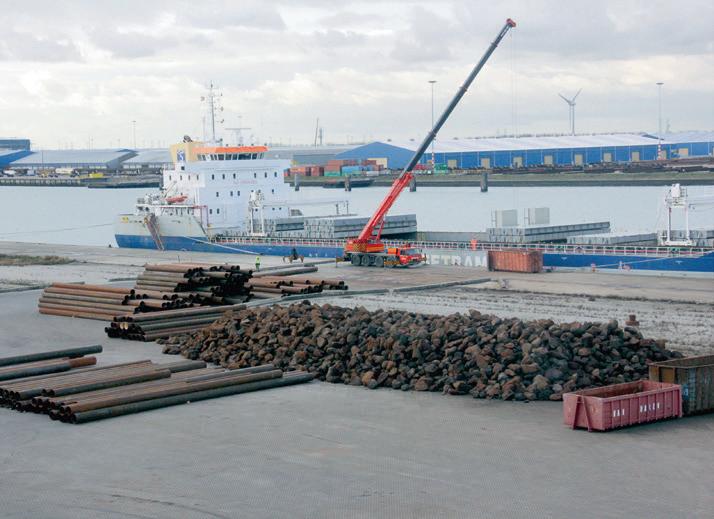

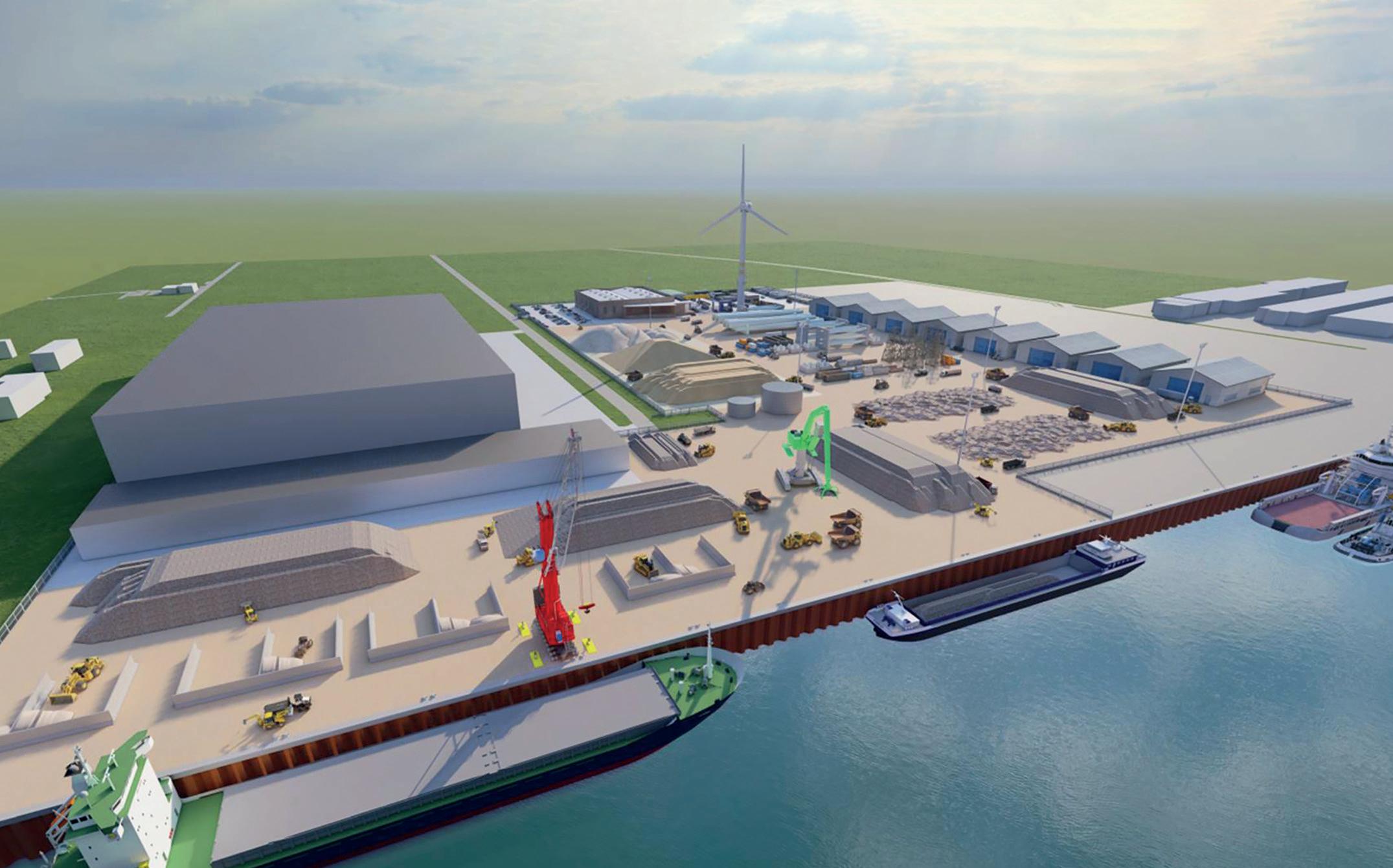
• Noorderkanaalhaven: North quay: 170 metres; South quay: 192 metres.
• Noorderkanaalhaven: North quay: 170 metres; South quay: 192 metres.
• Zuiderkanaalhaven: North quay: 225 metres; South quay: 230 metres.
• Zuiderkanaalhaven: North quay: 225 metres; South quay: 230 metres.
• Massagoedhaven: 978 metres.
• Massagoedhaven: 978 metres.
• Zevenaarhaven: North quay: 421 metres and 555 metres; South quay: 259 metres.
• Zevenaarhaven: North quay: 421 metres and 555 metres; South quay: 259 metres.
• Axelse Vlaktehaven: 290 metres.
• Axelse Vlaktehaven: 290 metres.
• Autrichehaven: 850 metres.
• Autrichehaven: 850 metres.
Braakmanhaven is part of North Sea Port, located directly on Western ScheIdt with no locks. Four berths for seagoing vesseIs and three berths for inland vessels.
Braakmanhaven is part of North Sea Port, located directly on Western ScheIdt with no locks. Four berths for seagoing vesseIs and three berths for inland vessels.
• Scheldt Jetty: 0ne berth for vessels up to 22,500 dwt or 200 metres LOA.
• Dow’s Scheldt Jetty: One berth for vessels up to 22,500 dwt or 200 metres LOA.
• Oceandock: North and south berths.
• Dow’s Oceandock: North and south berths.
• Zeeland Container Terminal: 185 metres.
• Zeeland Container Terminal: 185 metres.
• EVOS Terneuzen.
• 0iltanking Jetties: Jetty 0tter 1 and Jetty 0tter 2.
• Braakman: Docks A, B and C.
• Dow’s Braakman: Docks A, B and C.
Zeekanaal Ghent - Terneuzen: The depth of water in the canal is 13.5 m and there are no currents or tides. Inside the port there are fve large docks and three smaller docks, offering a total quay length of 31 kilometres for vessels up to 92,000 DWT.
smaller docks, offering a total quay length of
22 kilometers with a depth of water of at least 12.5 metres. All the docks have direct access to the canal.
Zeekanaal Ghent - Terneuzen: The depth of water in the canal is 13.5 m and there are no currents or tides. Inside the port there are five large docks and three 31 kilometres for vessels up to 92,000 DWT. 22 kilometers with a depth of water of at least 12.5 metres. All the docks have direct access to the canal.
• Kluizendok: Is a brand-new dock. Has a total quay length of 4,300 metres with a depth of water of 13.5 metres and a width of 350 metres.
• Kluizendok: Is a brand-new dock. Has a total quay length of 4,300 metres with a depth of water of 13.5 metres and a width of 350 metres.
• Rodenhuizedok: Quay on the southern side is 790 metres long with 13.5 metres of depth. Width of 270 metres.
• Rodenhuizedok: Quay on the southern side is 790 metres long with 13.5 metres of depth. Width of 270 metres.
• Mercatordok: Quay is 1,800 metres long with 13.5 metres of depth. Width of 250 metres.
• Mercatordok: Quay is 1,800 metres long with 13.5 metres of depth. Width of 250 metres.
• Alphonse Sifferdok: Quay is 4,800 metres long, with 12.5 – 13.5 metres depth. Width of 300 metres.
• Alphonse Sifferdok: Quay is 4,800 metres long, with 12.5 – 13.5 metres depth. Width of 300 metres.
• Grootdok, Noorddok, Middendok and Zuiddok: Total quay length of 6,855 metres. 6,575 metres with 13 metres depth of water, and 280 metres with 8.5 metres depth of water.
• Grootdok, Noorddok, Middendok and Zuiddok: Total quay length of 6,855 metres. 6,575 metres with 13 metres depth of water, and 280 metres with 8.5 metres depth of water.
Width: Grootdok: 150 metres
Width: Grootdok: 150 metres
Noorddok: 200 metres
Noorddok: 200 metres
Middendok: 250 metres Zuiddok: 220 metres
Middendok: 250 metres Zuiddok: 220 metres
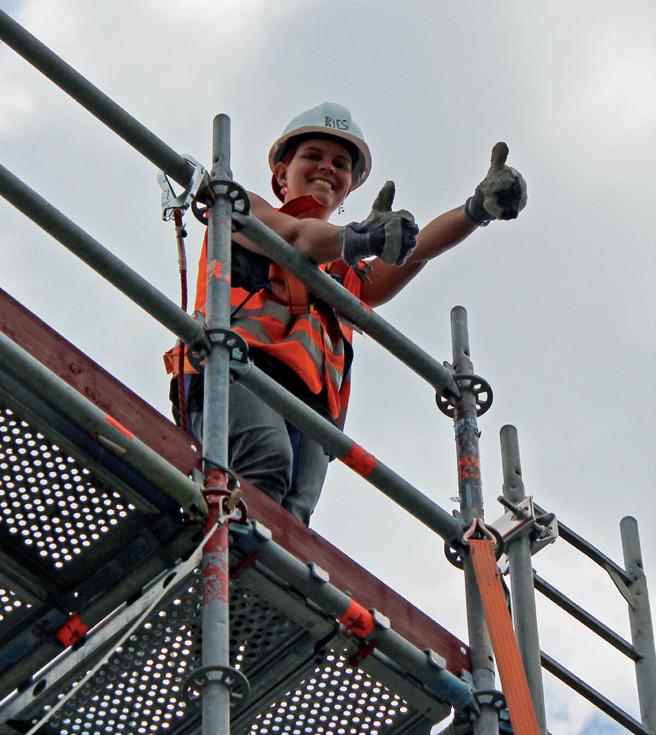
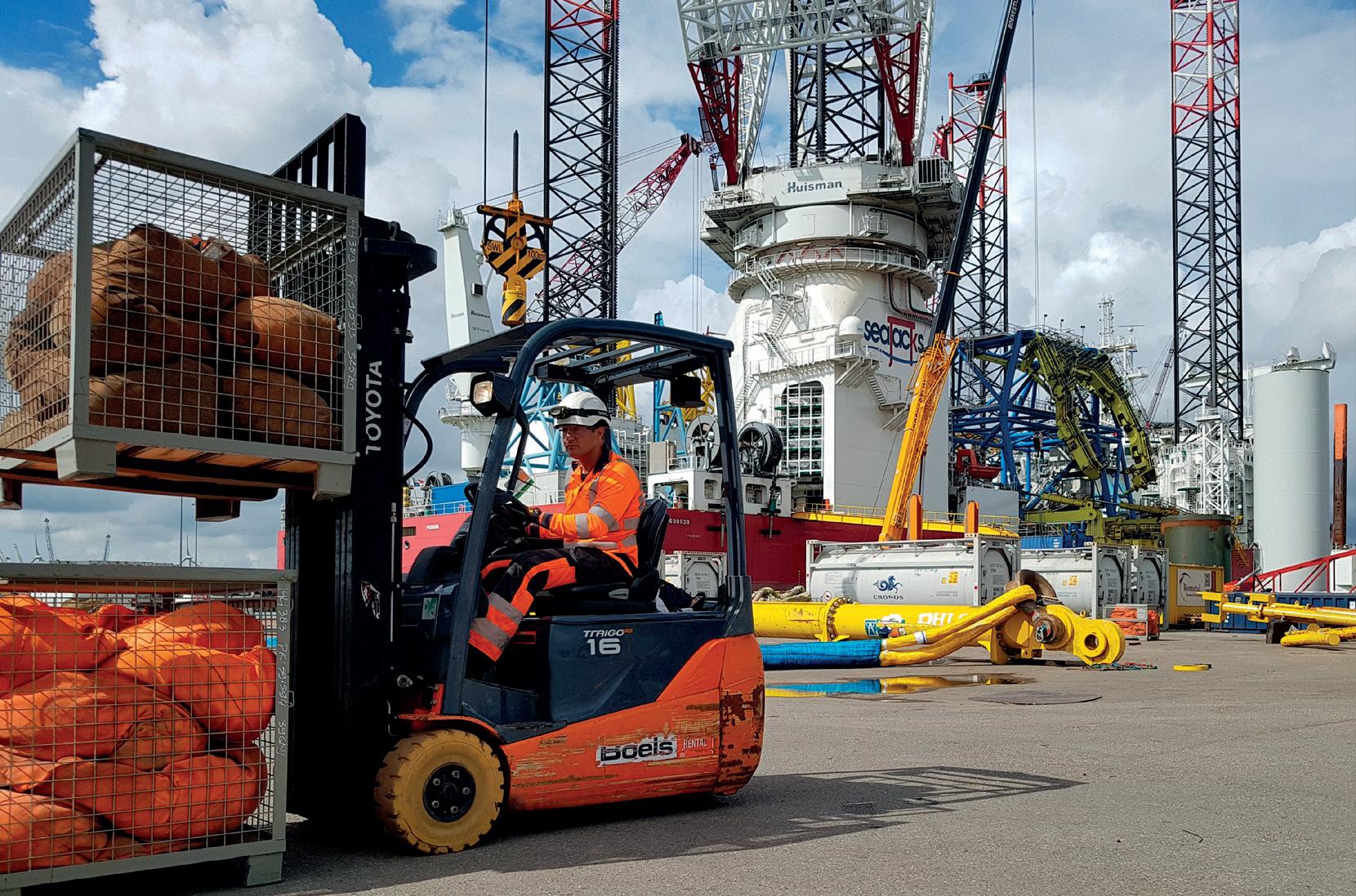
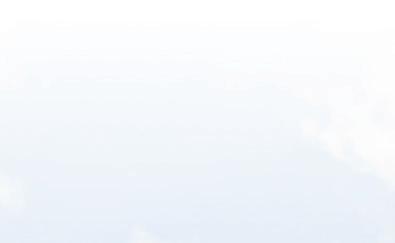



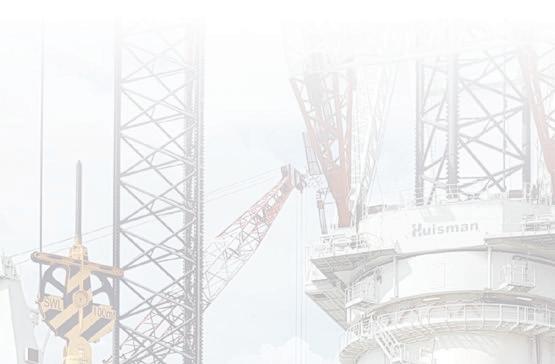



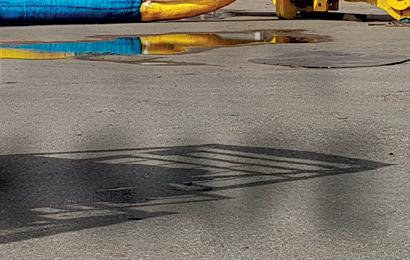

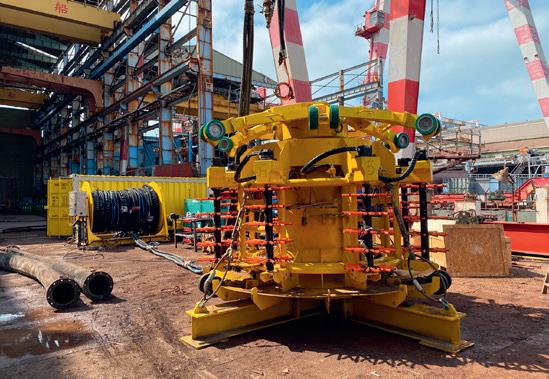


connec
promot
A.C. Rijnberg transportservice B.V. www.rijnberg.com
Aannemingsmaatschappij Van Gelder B.V. www.vangelder.com
ABN AMRO www.abnamro.nl
Access World Terminals B.V. www.accessworld.com
Adriaanse & van der Weel Advocaten www.avdw.nl
Aerssens & Partners www.aenpmakelaars.nl
Agro Minne www.agro-minne.be
Aquadrant B.V. www.aquadrant.com
Atlas Professionals www.atlasprofessionals.com
Baker Tilly N.V. www.bakertilly.nl
BMD Advies www.bmdzuid.nl
Boluda Towage Europe www.boluda.eu
Bouwgroep Peters B.V. www.bouwgroep-peters.nl
BOW Terminal www.bowterminal.nl
Brandtie www.brandtie.nl
Bulk Terminal Zeeland Services B.V. www.btzeeland.nl
CLdN www.cldn.com
Competence Development Center www.bbeu-cdc.org
Control Union Belgium NV www.petersoncontrolunion.com
Cordeel Nederland B.V. www.cordeel.nl
C.T.O.B. Transport & Logistics www.ctob-logistics.com
Customs Support Terneuzen www.customssupport.com
Damen Shiprepair Vlissingen www.damen.com
Danser Group www.danser.nl
DB Cargo Nederland N.V. www.nldb.cargo.com
De Baerdemaecker N.V. www.stukwerkers.com
De Pooter Personeelsdiensten www.depooter.nl
De Ruyter Training & Consultancy www.drtc.nl
De Zeeuwse Alliantie Notarissen www.dezeeuwsealliantie.nl
Delta Safe Security Services B.V. www.delta-safe.nl
DFDS Seaways Belgium www.dfds.com
dNM www.dnm.nl
DOC Logistics B.V. www.dutchcontractors.com
DOW Benelux B.V. www.dow.com
Draftec B.V. www.draftec.nl
DRV Accountants & Adviseurs www.drv.nl
Dutch Marine B.V. www.dutchmarinebv.com
Elloro www.elloro.nl
ELTEN Benelux B.V. www.elten.com
Embedded Coaching & Consultancy www.ecc-coach.nl
Epesi B.V. www.epesi.nl
Euro-Mit Staal B.V. www.euro-mit-staal.com
Euro-Silo N.V. www.eurosilo.be
Evos Ghent NV www.evos.eu
Evos Terneuzen B.V. www.evos.eu
Feyter Group www.feyter.com
Firma Klouwers Terneuzen www.klouwers.nl
Fletcher Hotel-Restaurant Arion-Vlissingen www.fetcherhotelvlissingen.nl
Flushing Marine & Ofshore B.V. www.fushingmo.com
Flushing Shipping Agencies www.fsagencies.com
FMJ E & I Zeeland B.V. www.fmj.nl
Gould services www.foundgould.com
Green Blue Ofshore Terminal www.greenblueot.nl
H4A www.h4a.nl
Havenwerk B.V. www.havenwerk.nl
Henk Kramer Communicatie www.henkkramer.nl
Heros Sluiskil B.V. www.heros.nl
Hoondert ‘s-Heerenhoek www.kampsstraalbedrijf.nl
Hoondert Services & Decommissioning www.hsd.nl
HR Expat Services www.hrxpats.com
IBS Staalbouw B.V. www.ibs-hallenbouw.nl
ICL-IP Terneuzen B.V. www.iclip-terneuzen.nl
IGL B.V. www.igl.nl
ING Business Banking www.ing.nl/zakelijk
Ingenieurbureau Walhout Civil B.V. www.walhoutcivil.com
Interface Terminal Gent (ITG) www.stukwerkers.com
Interlashing B.V. www.interlashing.com
JB Nautic Safety B.V. www.jbnauticsafety.nl
Jonkman Opleidingen B.V. www.jonkmanopleidingen.nl
Justion Advocaten www.justionadvocaten.nl
Kamps Straal- en Industriële Spuitwerken www.kampsstraalbedrijf.nl
Katoen Natie Westerschelde B.V. www.katoennatie.com
Kloosterboer Vlissingen B.V. www.kloosterboer.nl
Koch adviesgroep Ingenieurs & Architecten www.kochadviesgroep.nl
Koolwijk Shipstores B.V. www.shipstores.nl
KWS Infra/Aquavia www.kws.nl
Labojuice B.V. www.labojuice.nl
Lalemant N.V., Lalemant Trucking N.V. www.lalemant.com
Legrant Freight Management B.V www.legrant.eu
LGH BVBA www.lgh.eu
Liftal Hijstechniek www.liftal.com
Loodswezen Regio Scheldemonden www.loodswezen.nl
Luctor Belting Nederland B.V. www.luctorbelting.com
M-Force www.m-force.nl
Maaskade Bevrachters Belgium www.maaskade.com
Mammoet Nederland B.V. www.mammoet.com
Maritiem & Logistiek College de Ruyter www.scalda.nl
Martens Renewables www.martenscleaning.nl
MMPS www.mmps.nl
Montis Mooring- and Boatservice B.V. www.montismooring.com
Multraship Towage & Salvage www.multraship.com
Municipality of Borsele www.borsele.nl
Municipality of Middelburg www.middelburg.nl
Municipality of Terneuzen www.terneuzen.nl
Municipality of Vlissingen www.vlissingen.nl
MVH Group www.mvh-group.com
Navonus N.V. www.navonus.be
North Sea Port www.northseaport.com
N.V. Economische Impuls Zeeland www.impulszeeland.nl
N.V. Westerscheldetunnel www.westerscheldetunnel.nl
Oceanwide Personnel Services B.V. www.oceanwidecrew.com
OMC Services B.V. www.linkedin.com/in/chvdo
| connec
| promot e
Ørsted Nederland www.orsted.nl
Outokumpu Stainless B.V. www.outokumpu.com
Ovet B.V. www.ovet.nl
Ovet Shipping B.V. www.ovetshipping.com
Pfauth Logistics B.V. www.pfauth.nl
PMI Polaris Marine Inspections B.V. www.polarismarineinspections.nl
PreZero www.prezero.nl
Prior Group www.priorgroup.nl
PTC B.A. www.ptcba.nl
Rabobank Oosterschelde www.rabobank.nl/oosterschelde
Rabobank Walcheren-Noord Beveland www.rabobank.nl/wnb
Rabobank Zeeuws-Vlaanderen www.rabobank.nl
Royal HaskoningDHV Nederland B.V. www.royalhaskoningdhv.com
S.T.T. B.V. www.agency-stt.com
Sagro Aannemingsmij. Zeeland B.V. www.sagro.nl
Sarens Nederland www.sarens.com
Saybolt Nederland B.V. www.corelab.com/rd/saybolt
Schelde Exotech www.exotech.nl
Schipper Groep www.schippergroep.nl
SEA-invest www.sea-invest.com
Seatrade Rotterdam B.V. www.seatraderotterdam.nl
SEC Catering www.seccatering.nl
Secil Cement www.secil.pt
SFP Zeeland www.sfp-group.nl
SGS Nederland B.V. www.sgs.com
Shipyard Reimerswaal www.shipyardreimerswaal.com
Simons Bouwgroep B.V. www.simonsbg.nl
Sloecentrale www.sloecentrale.nl
Sorteerbedrijf Vlissingen B.V. www.sorteerbedrijfvlissingen.nl
SPIE Nederland B.V. www.spie-nl.com
Stukwerkers Havenbedrijf N.V. www.stukwerkers.com
Supermaritime Nederland B.V. www.supermaritime.com
Swagemakers Intermodaal Transport B.V. www.swagemakers.nl
Sweco Nederland B.V. www.sweco.nl
T.I.M.E. Service Catalyst Handling B.V. www.ts-cat.com
Tanido B.V. Sworn Marine Surveyors www.tanido.com
Tank Terminal Sluiskil www.tankterminal-sluiskil.nl
Tauris B.V. www.tauris.be
Terberg Tractors Belgium www.terbergspecialvehicles.com
Terneuzen Port Service www.terneuzenportservice.nl
Terneuzen Processing Technologies www.tpt.nl
The Safety Network www.thesafetynetwork.nl
Timmerman Industrial Repairs www.ltimmerman.nl
TMS Terneuzen B.V. www.tmsnl.com
TOS Port & Logistics B.V. www.tos.nl
Transuniverse Group N.V. www.transuniverse.be
Tri-Modal Containerterminal Terneuzen www.vlaeynatie.eu
Try-Act EWIV www.try-act.eu
Vakwerk www.leerbedrijfvakwerk.nl
Van Ameyde Marine Vlissingen www.ameydemarine.com
van Hoorebeke Timber N.V. www.vanhoorebeke.com
Van Keulen Transport B.V. www.vankeulentransport.nl
Verbrugge Internationale Wegtransporten B.V. www.verbruggeinternational.com
Verbrugge Marine B.V. www.verbruggeinternational.com
Verbrugge Terminals B.V. www.verbruggeinternational.com
Verenigde Bootlieden B.V. www.bootlieden.nl
Vlaeynatie B.V. www.vlaeynatie.eu
Vlissingse Bootliedenwacht B.V. www.vlb.vlissingen.nl
Vopak Agencies Terneuzen B.V. www.vopakagencies.com
Wagenborg Agencies B.V. www.wagenborg.com
Westerschelde Ferry B.V. www.westerscheldeferry.nl
Wielemaker B.V. www.wielemaker.nl
Yellow & Finch Publishers www.ynfpublishers.com
Zeeland Bunkering www.zeelandbunkering.nl
Zeeland Cruise Port www.zeelandcruiseport.com
Zeeland Maritime Cleaning www.zmcleaning.nl
Zeeland Refnery www.zeelandrefnery.nl
Zeeland Sugar Terminal www.vlaeynatie.eu
Zéfranco Communicatieservice Frans www.zefranco.com
ZTZ Logistics B.V. www.ztzlogistics.com

Covering the port area of North Sea Port, PortNews is the offcial publication of the Promotion Council North Sea Port and port authority North Sea Port.
Distributed to a wide international audience, the high quality quarterly magazine promotes the activities of companies active in the ports to key customers, business partners, stakeholders, as well as at major international trade events.
PortNews is available in hard copy as well as a digital version. Each issue has approximately 10,000 readers.
The content of PortNews is the responsibility of the Editorial Committee.
Contact:
• Henk de Haas, Chairman, Promotion Council North Sea Port
• Michael Moreau, Communication Manager, North Sea Port
• Charles van den Oosterkamp, Director, OMC Services BV
Special thanks to everyone who kindly contributed their time and expertise to put together this issue of PortNews. Find out more about contributing to future issues of PortNews by contacting Charles van den Oosterkamp, info@omc-services.com, tel. +31 (0)6 10 979 655.
Would you like a free subscription to PortNews, or would you like to receive additional copies of PortNews free of charge for promoting the port and your organisation to your business relations? Please contact the publisher at info@pc-nsp.com or contacteer@ northseaport.com.
P.O. Box 132 4530 AC Terneuzen, The Netherlands T +31 (0)115 647 400
John Kennedylaan 32, Harbour 3000A, 9042 Ghent, Belgium T +32 (0)9 251 0550 E contacteer@northseaport.com I www.northseaport.com
Follow us on:
Copyright 2022. All rights reserved.
The contents of this magazine may not be reproduced in whole or in part without the express written consent of the publisher(s). PortNews is a production of OMC Services BV on behalf of the Promotion Council North Sea Port and North Sea Port. The opinions expressed in PortNews are not necessarily those of the Editorial Committee or the publishers. While every effort has been made to ensure the accuracy of information in PortNews, no liability can be accepted for any errors or omissions.
meet | connec t | promot e P.O. Box 5130 4380 KC Vlissingen
The Netherlands
T +31 (0)118 491 320 E info@pc-nsp.com I www.pc-nsp.com
Follow us on:
Charles van den Oosterkamp
Arno Dirkzwager
Daniela Markovic
Jean-Louis Vandevoorde
Contact E info@omc-services.com T +31 (0)6 10 979 655

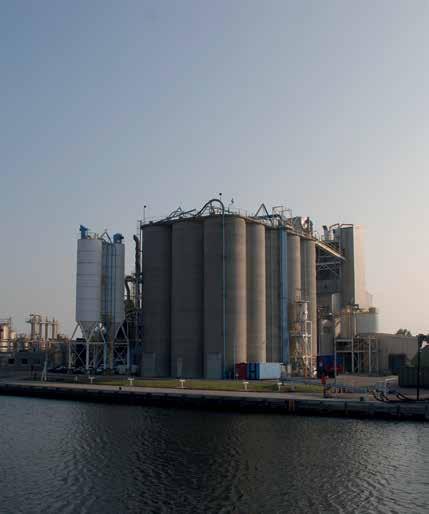
A thriving organisation focused on safety and delivering with excellence, proud of our growing business, strategically located in Terneuzen and our global partnerships.

TPT offers a full range of specialised services with data-centric production processes and dedicated logistics management.
Investing in tomorrow. Ready for the future.

